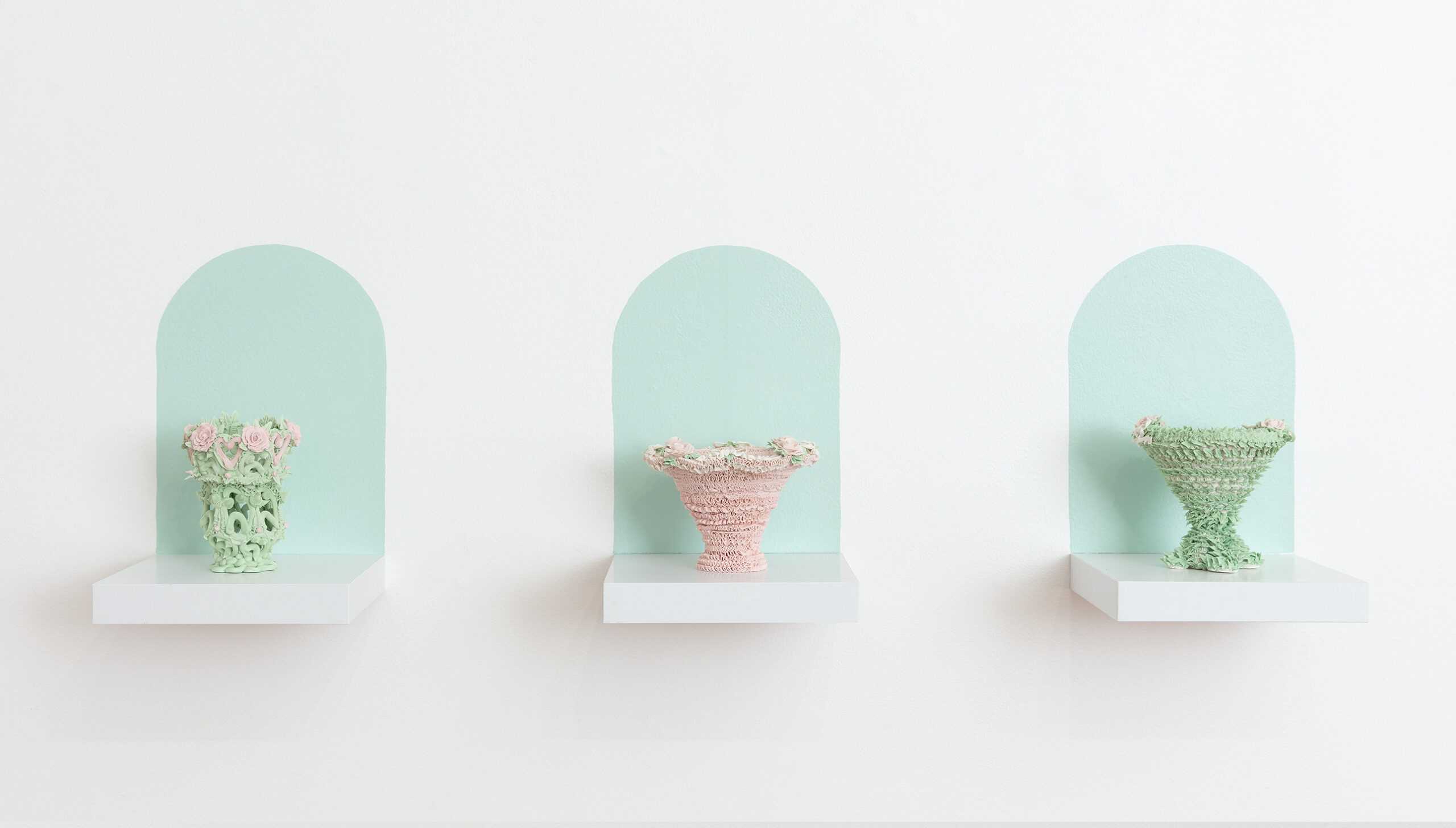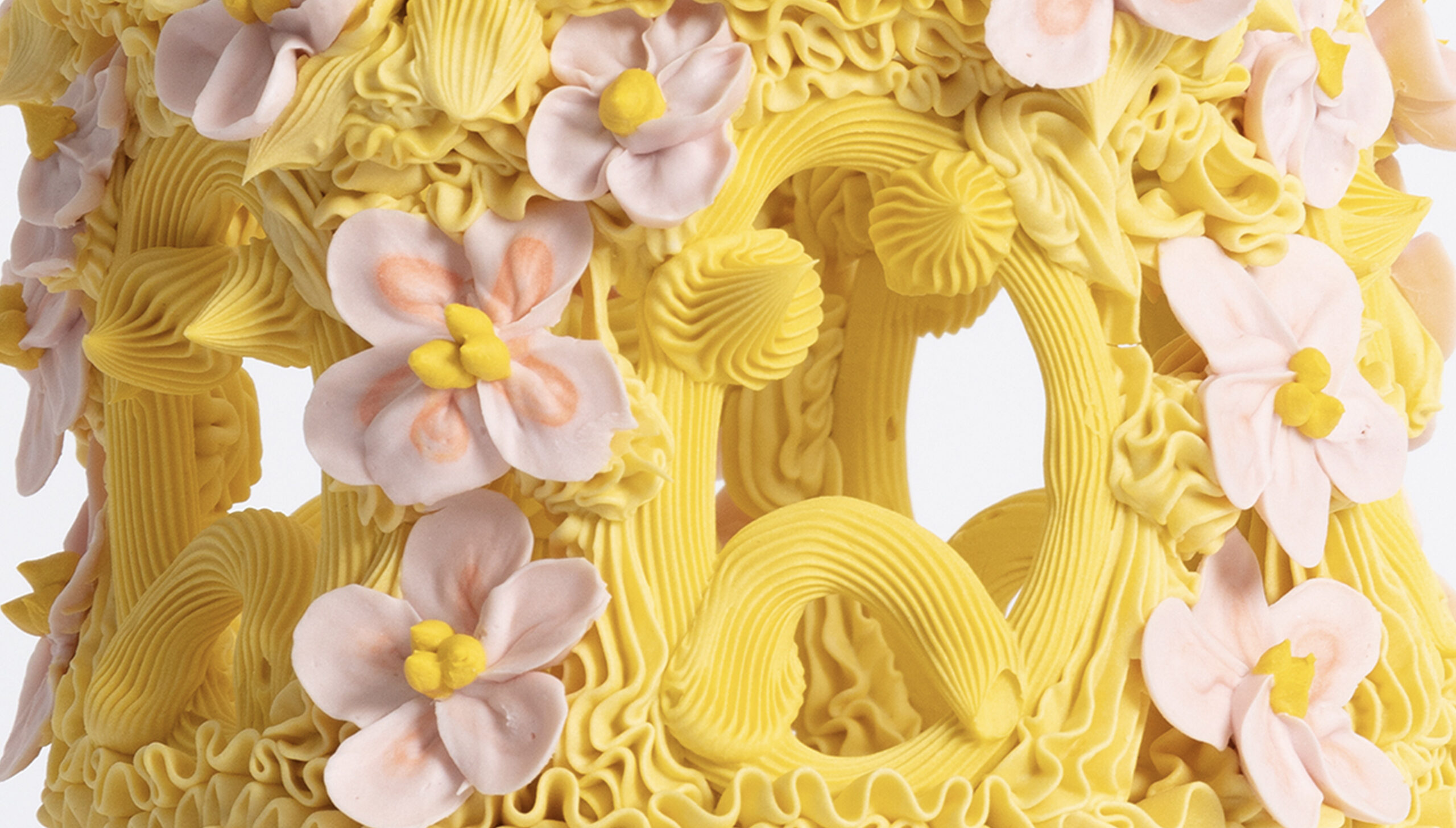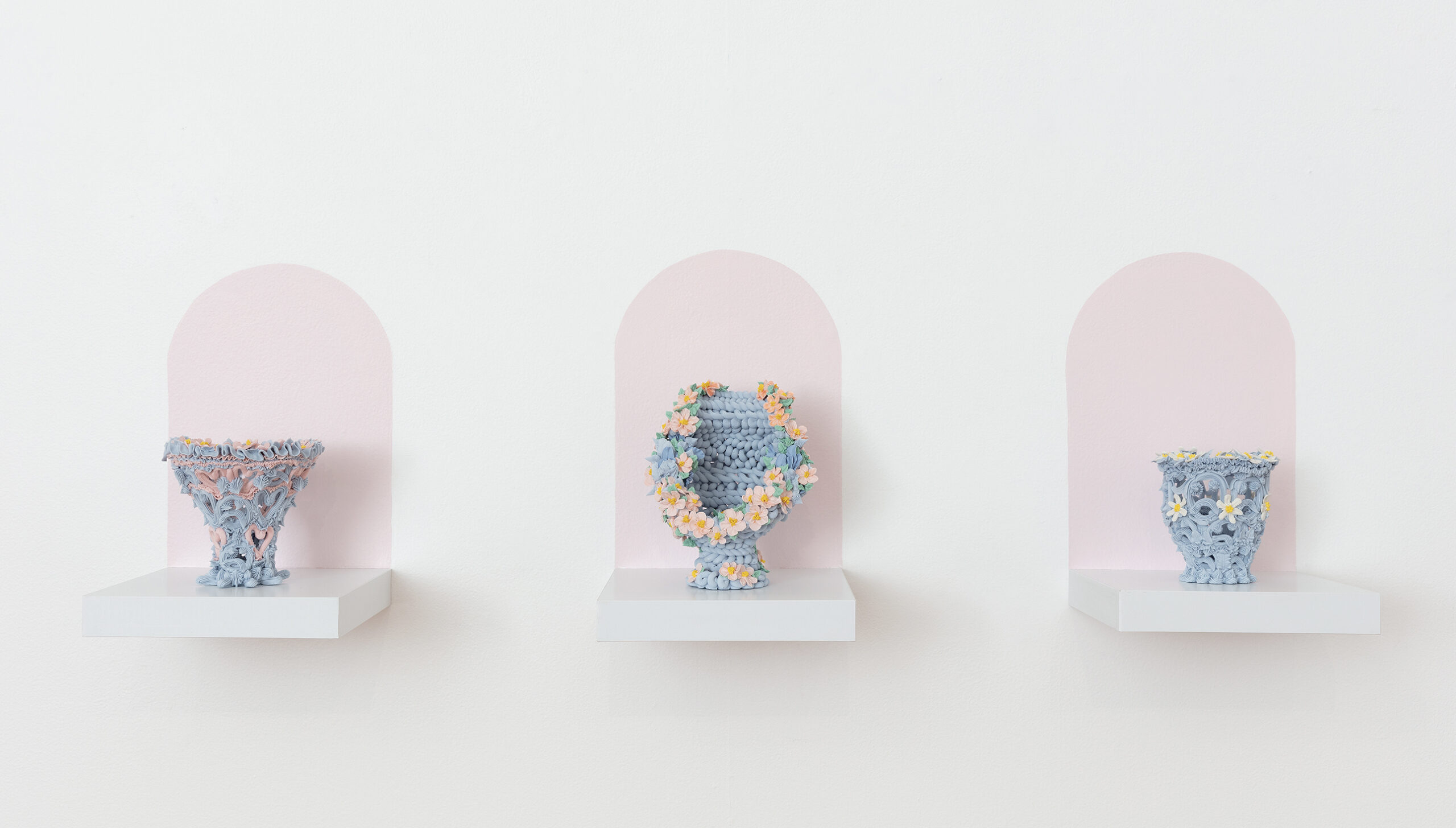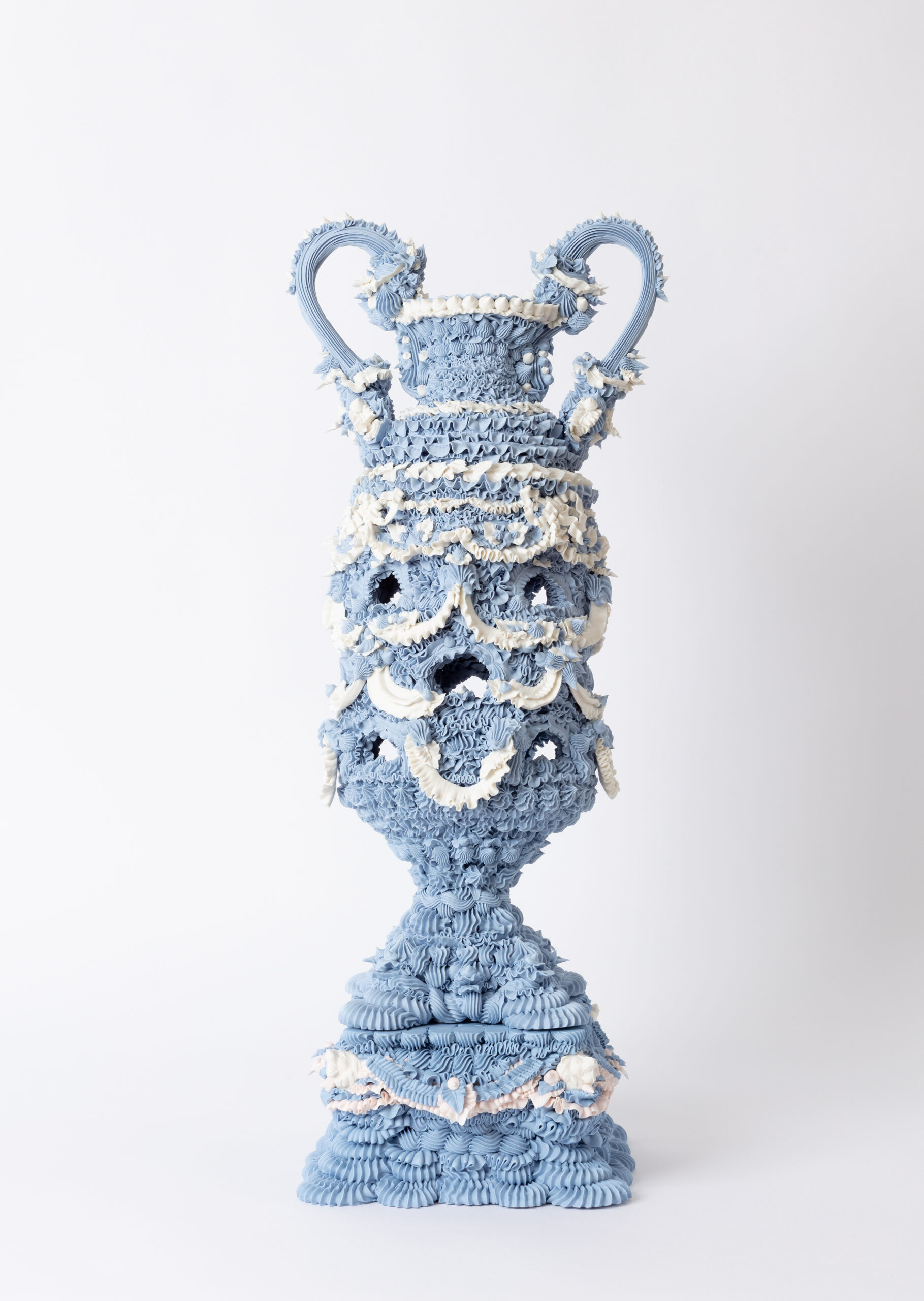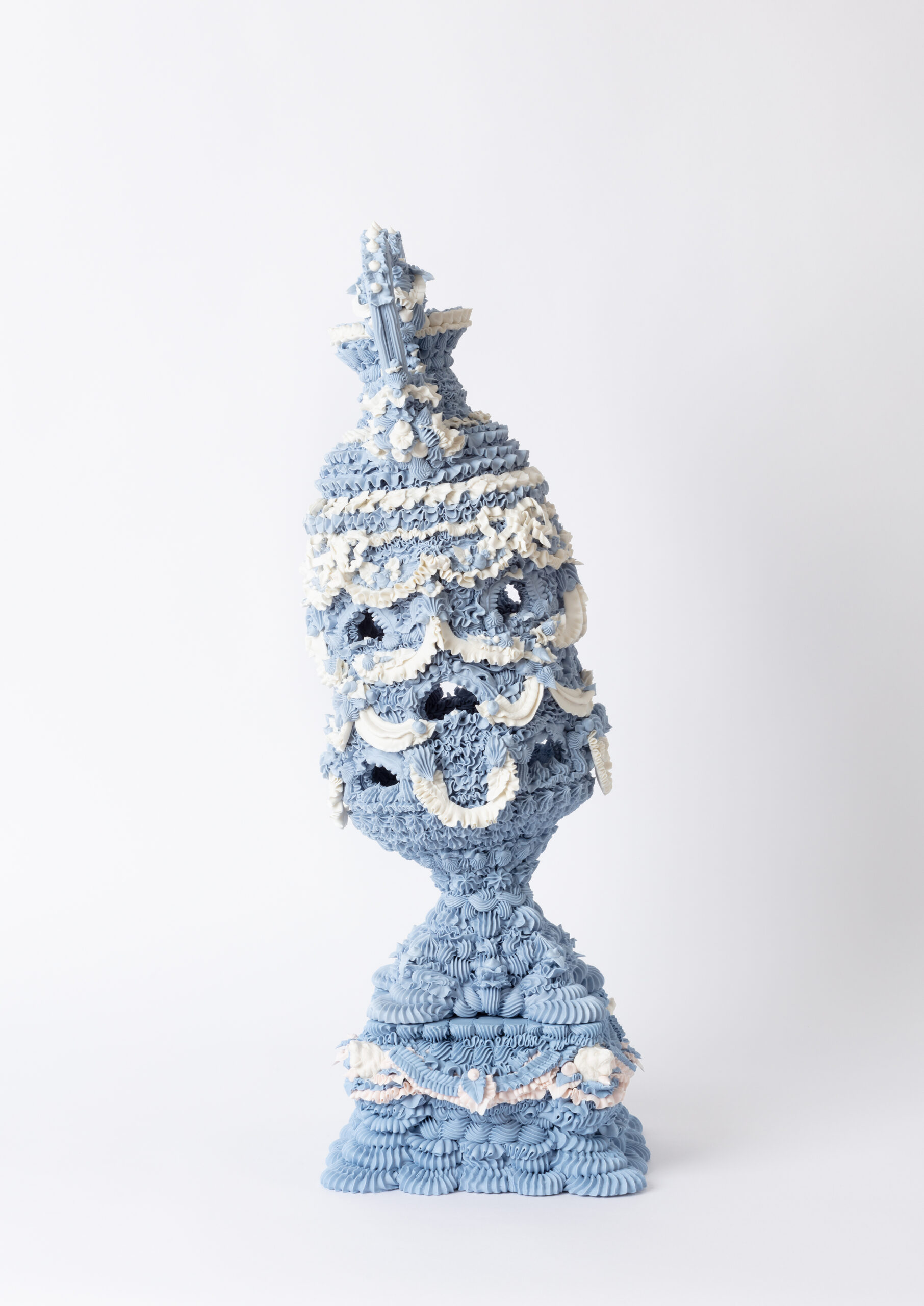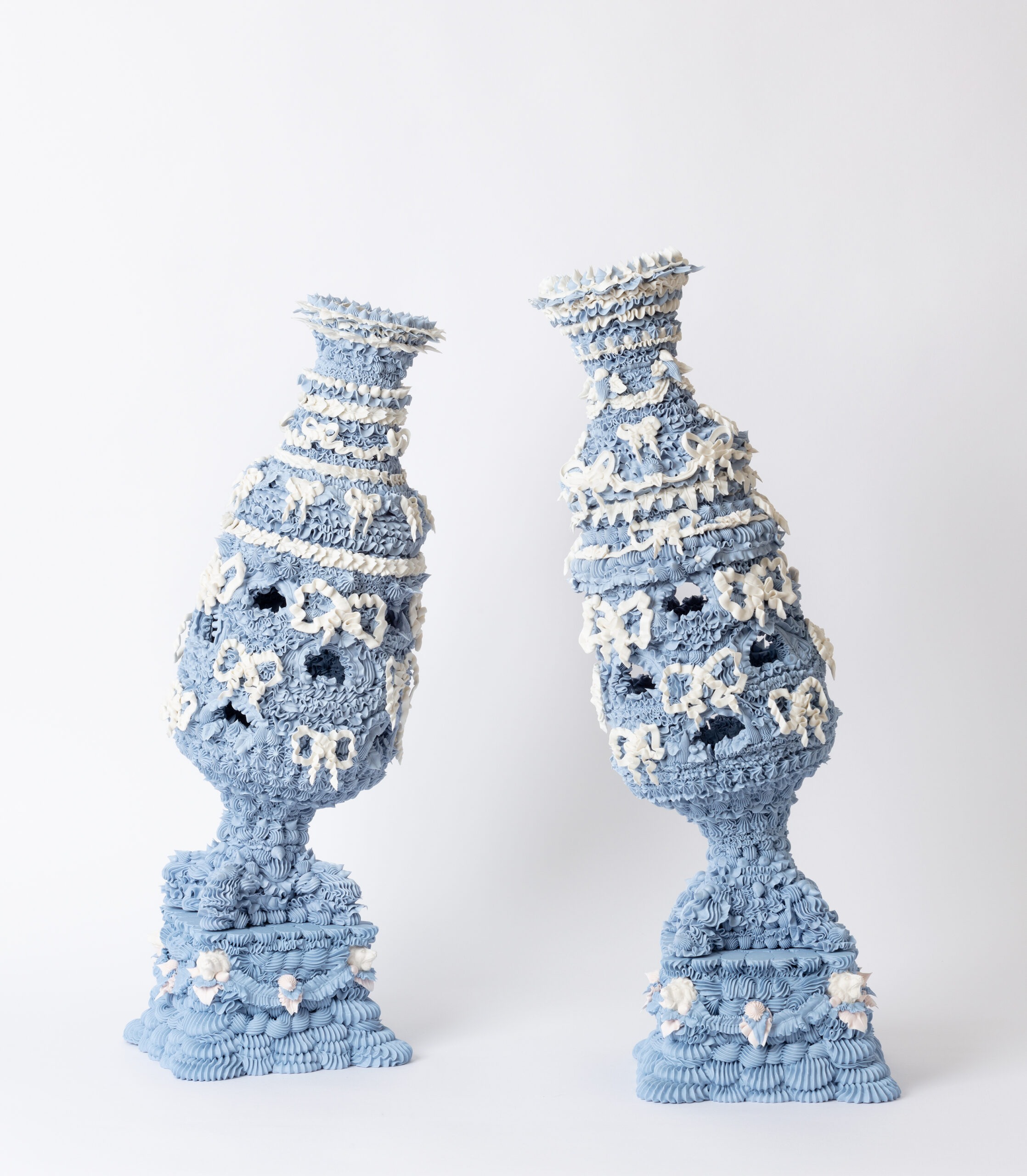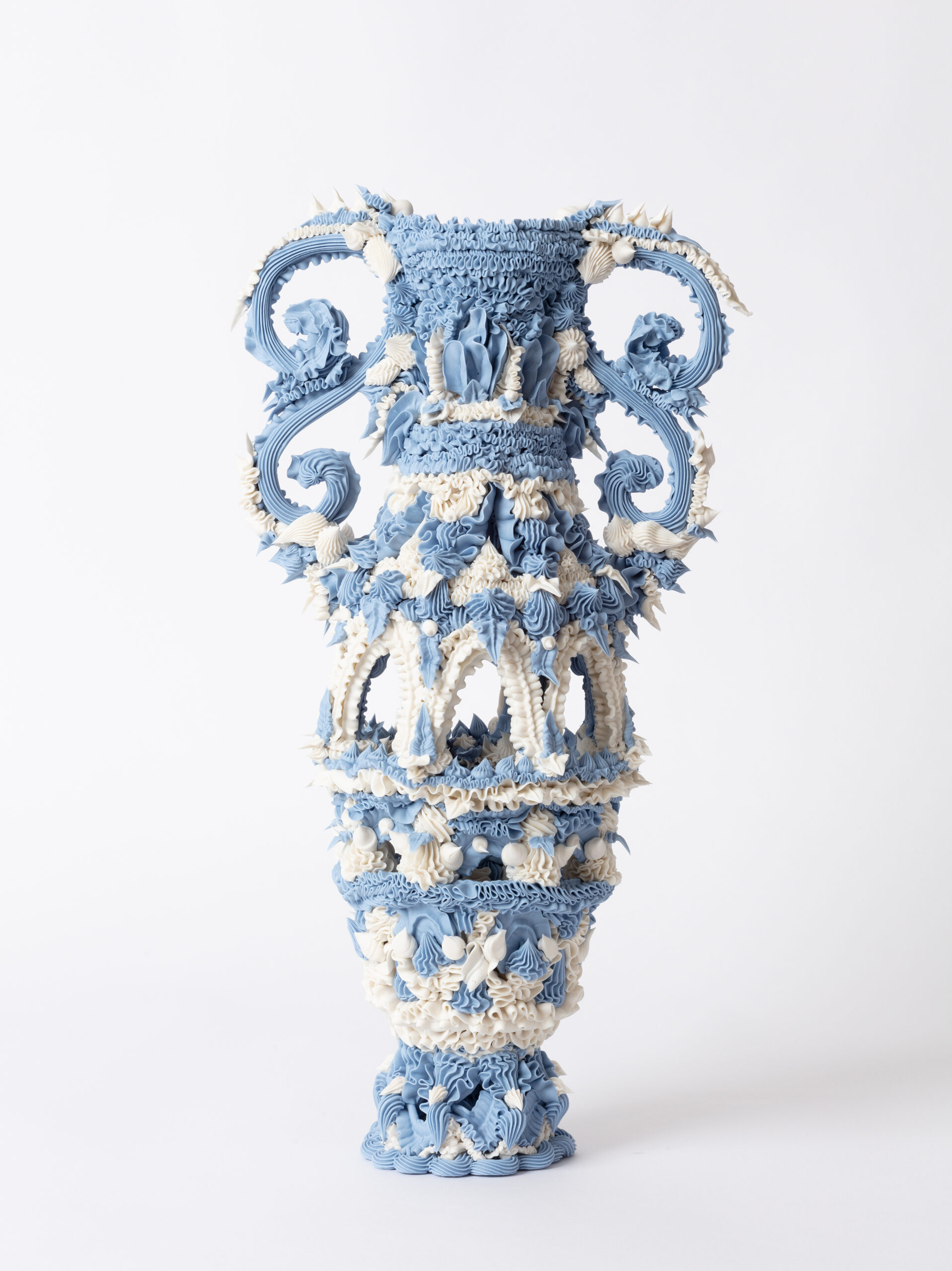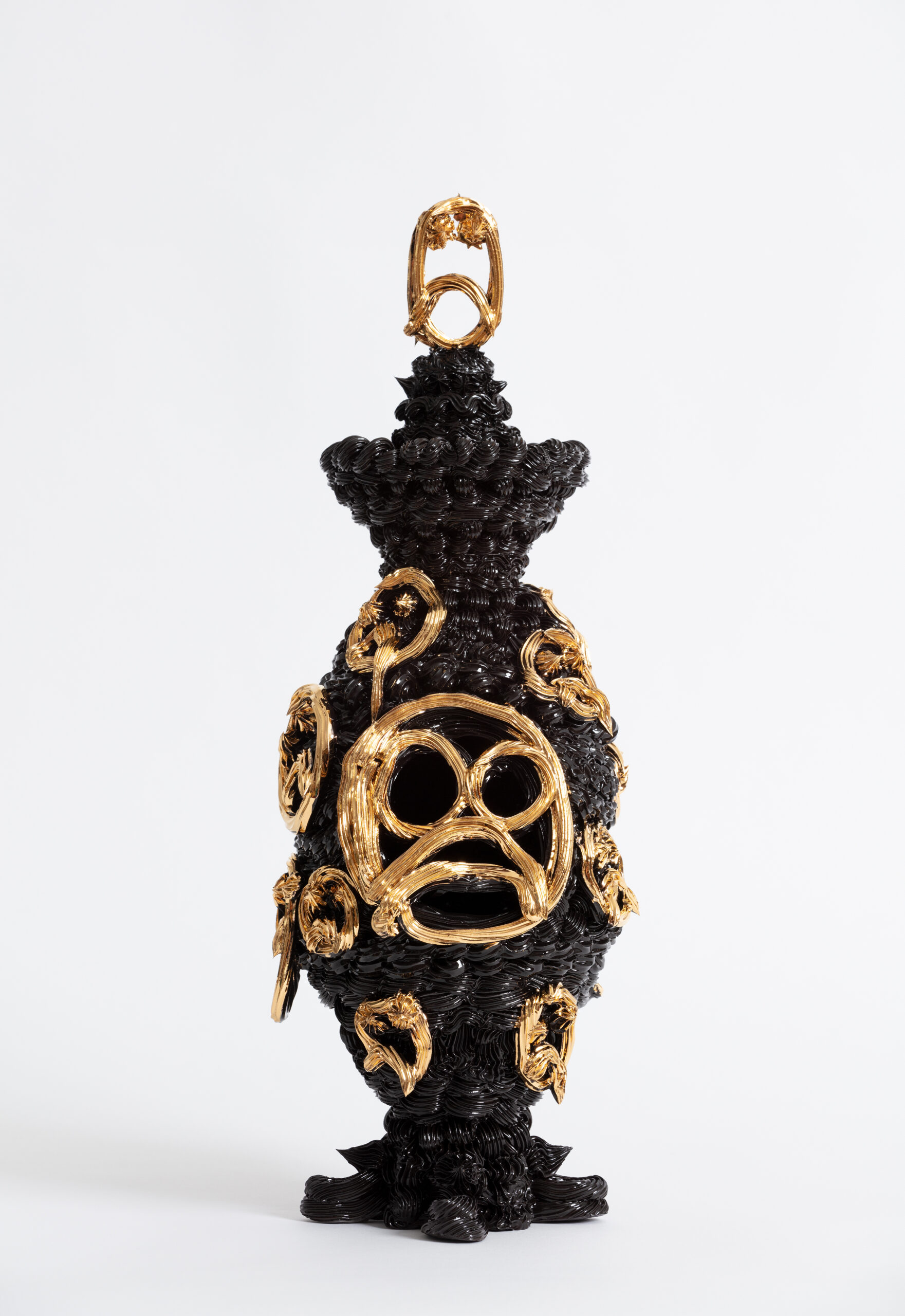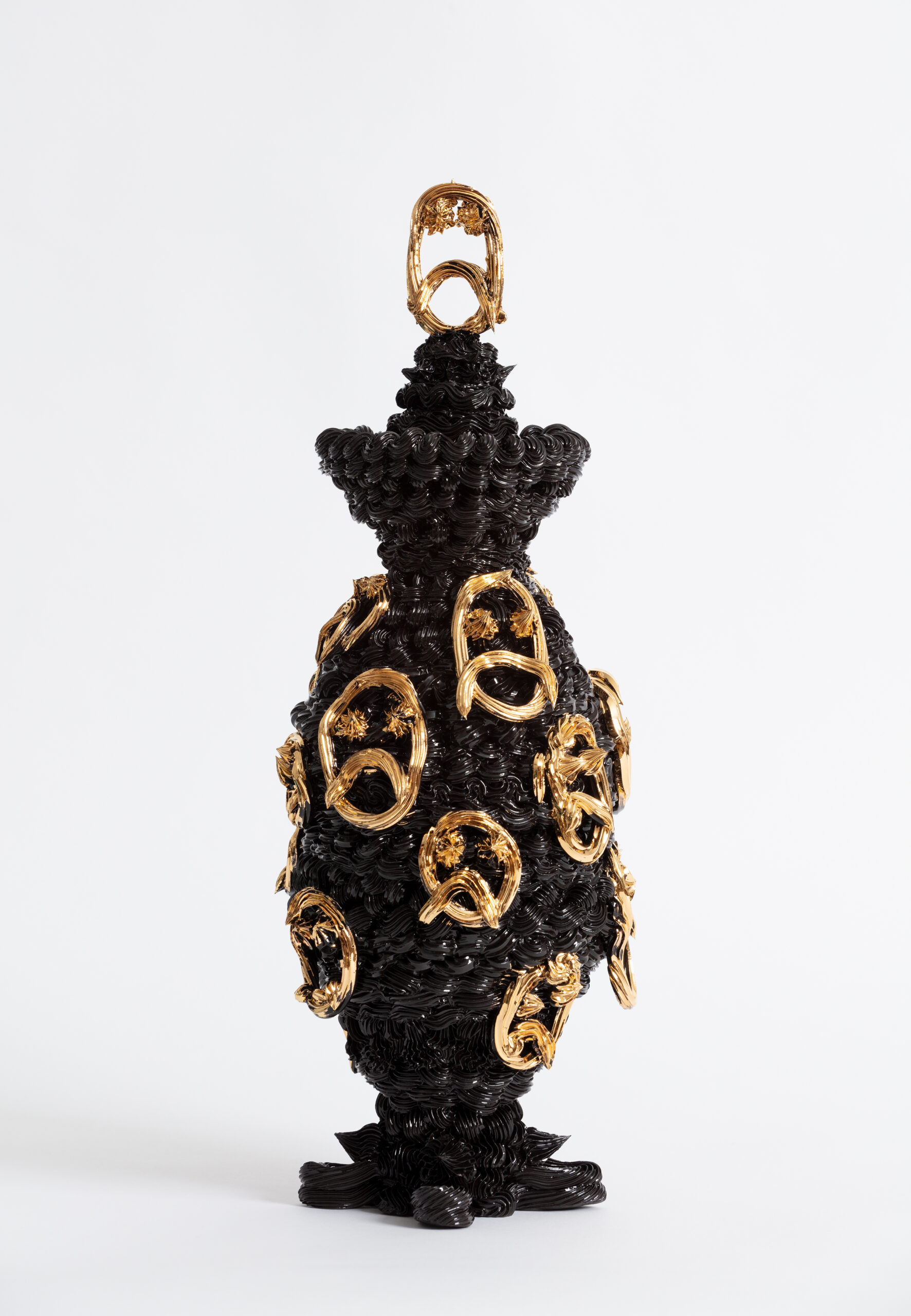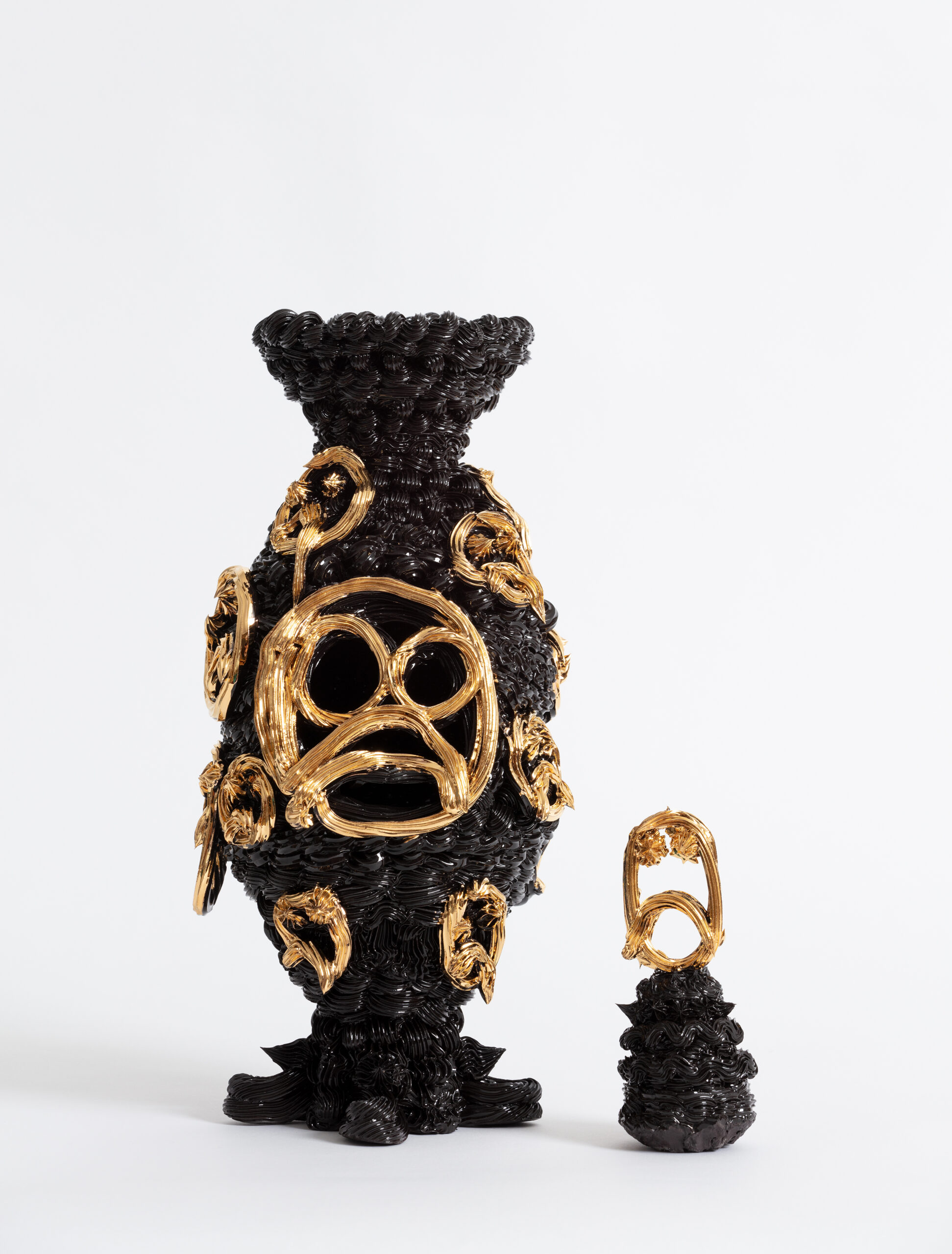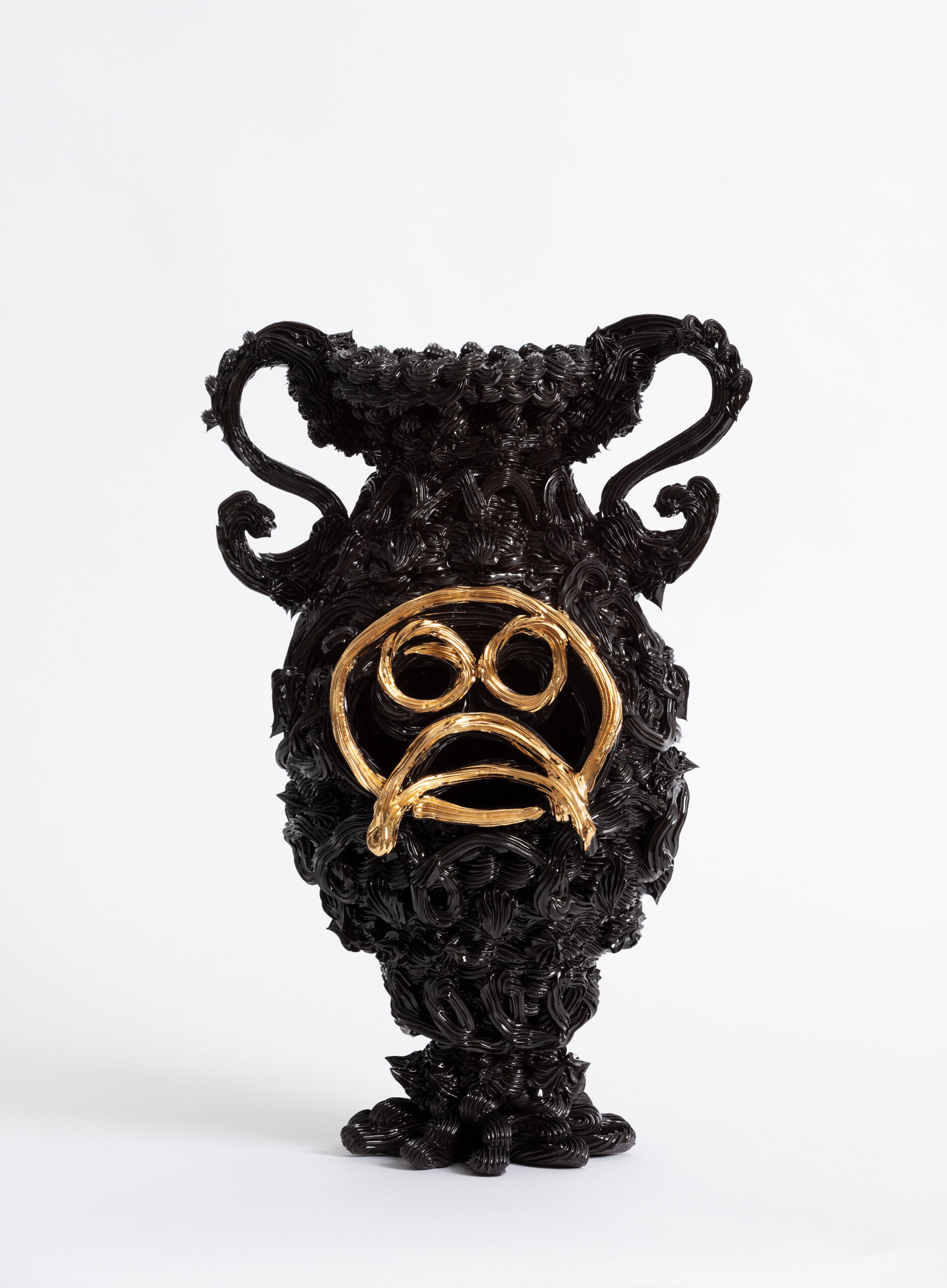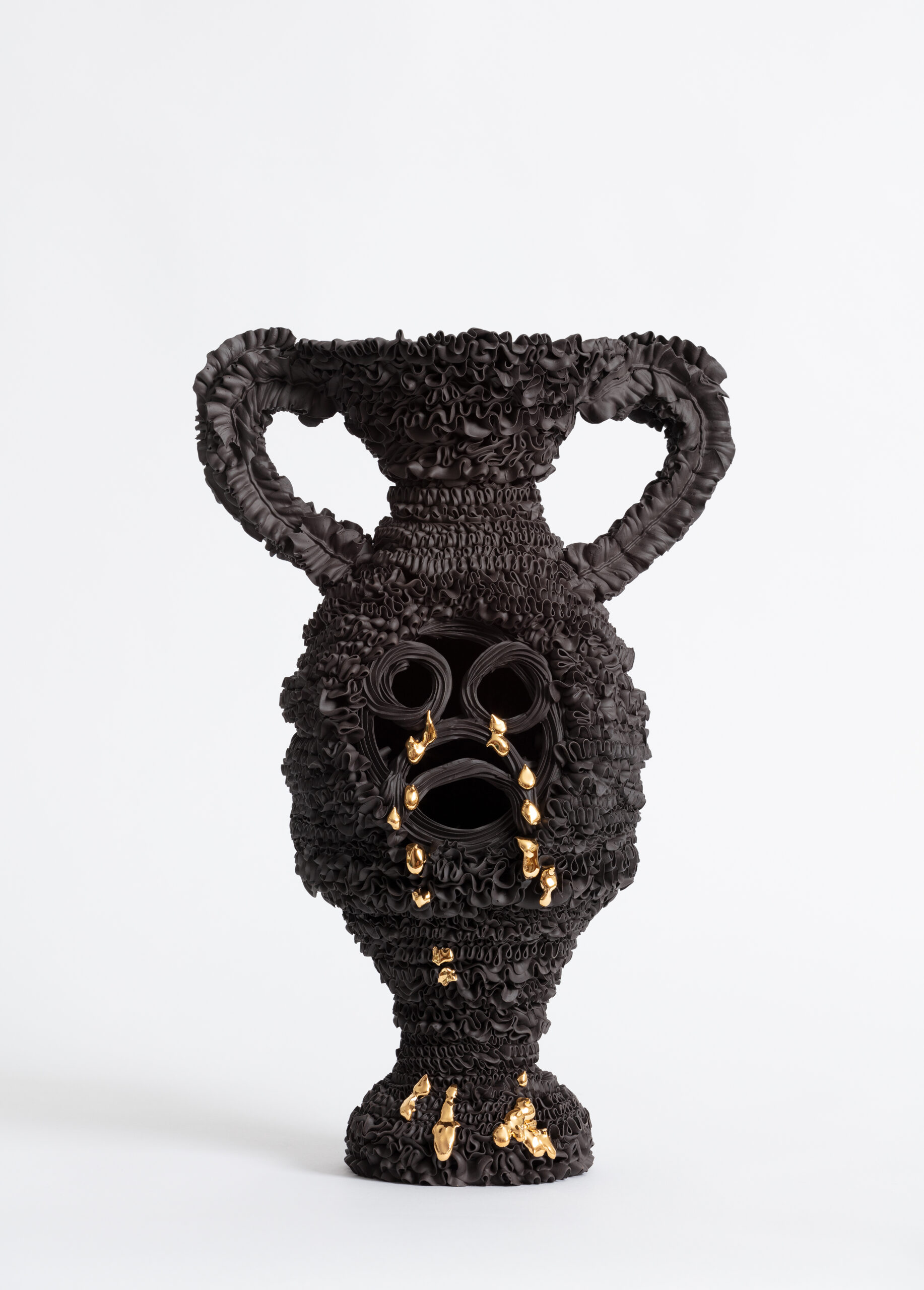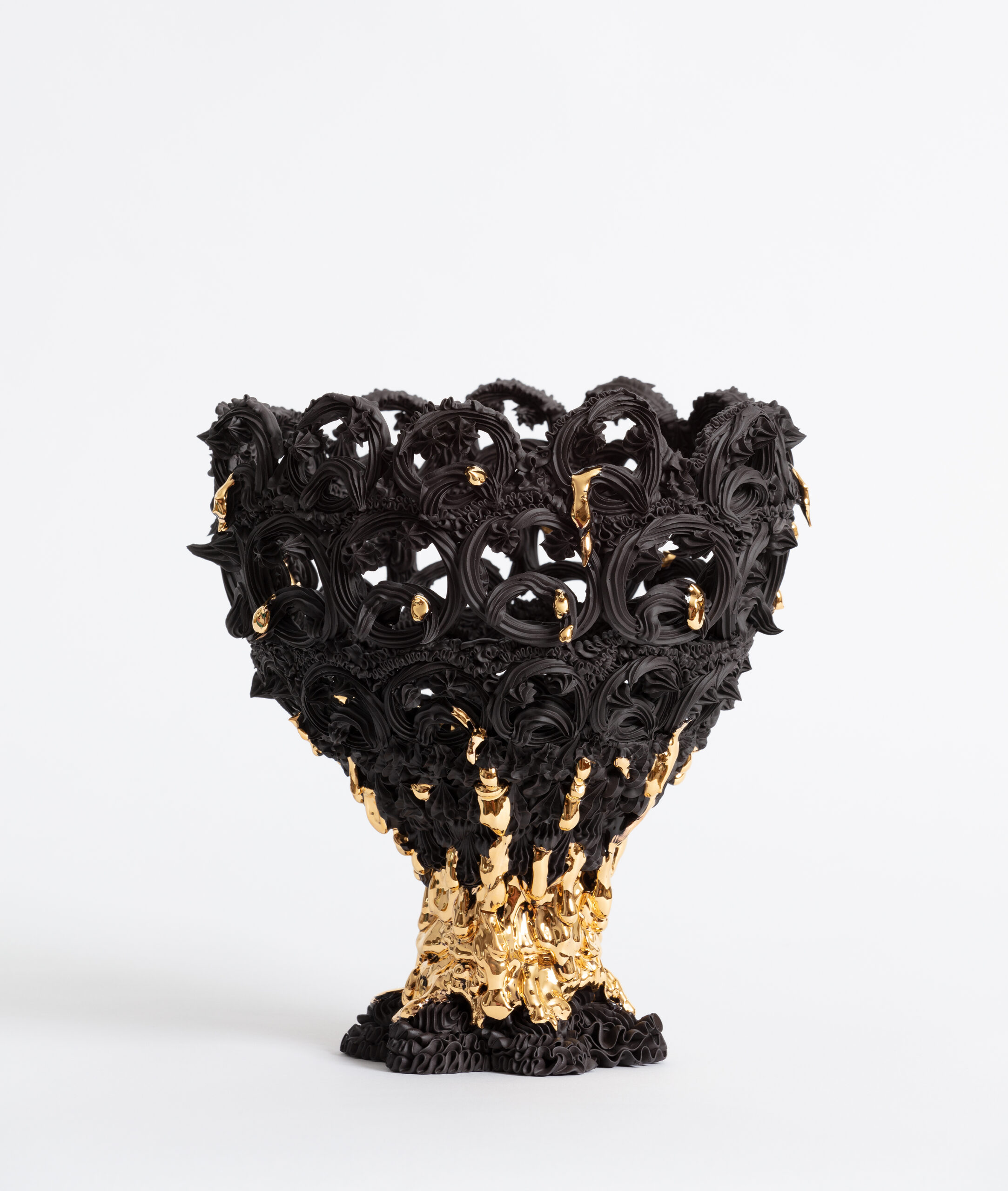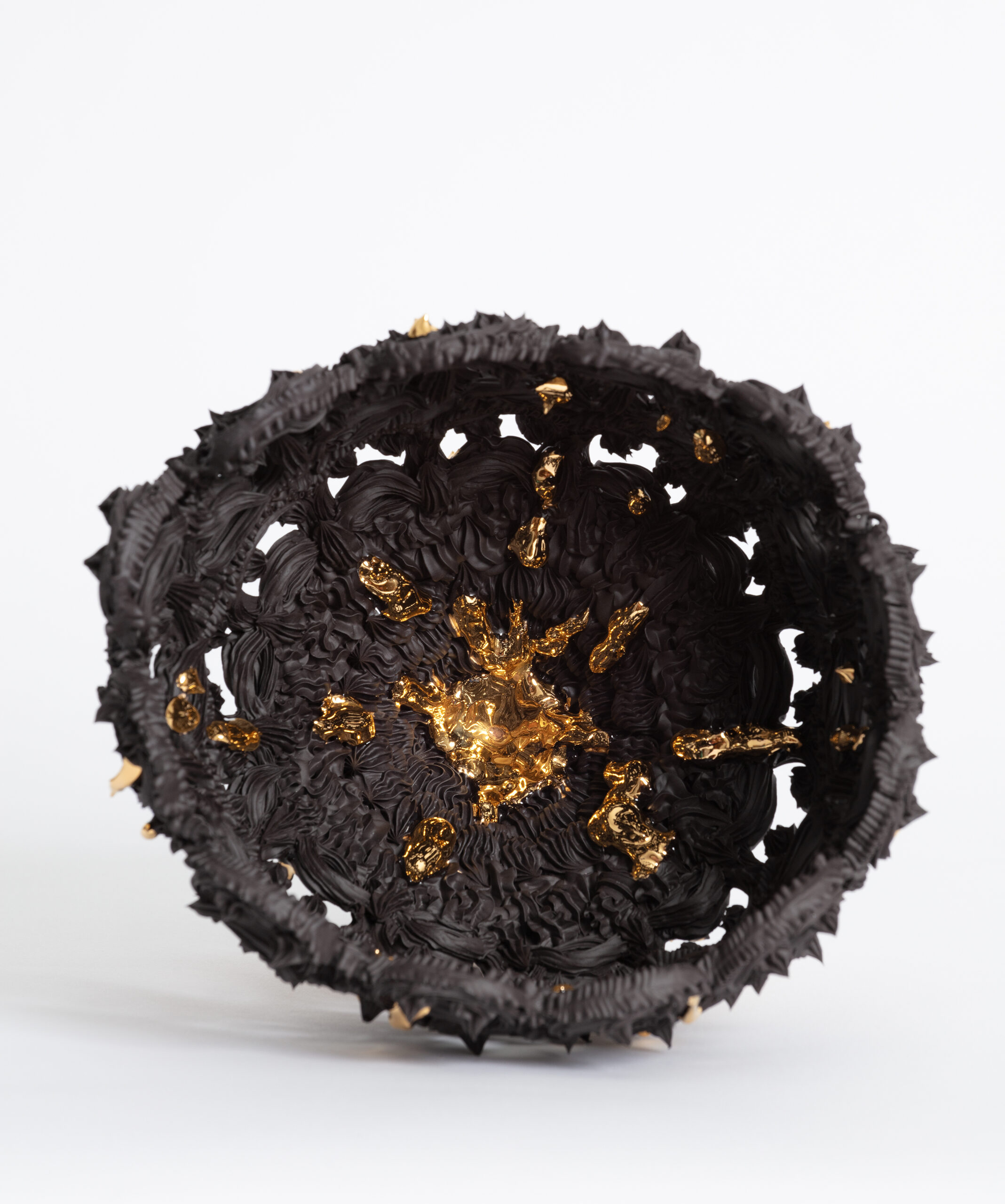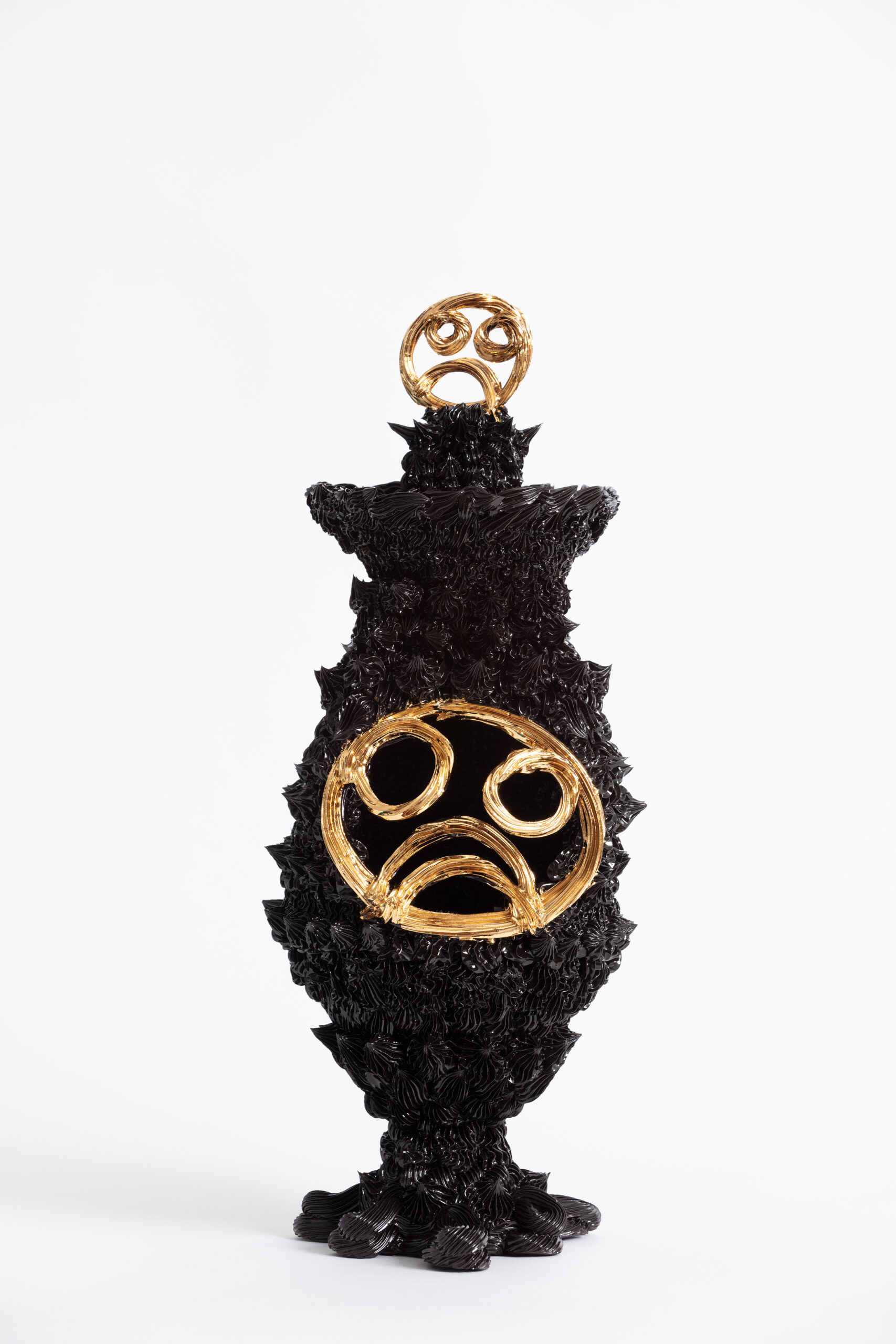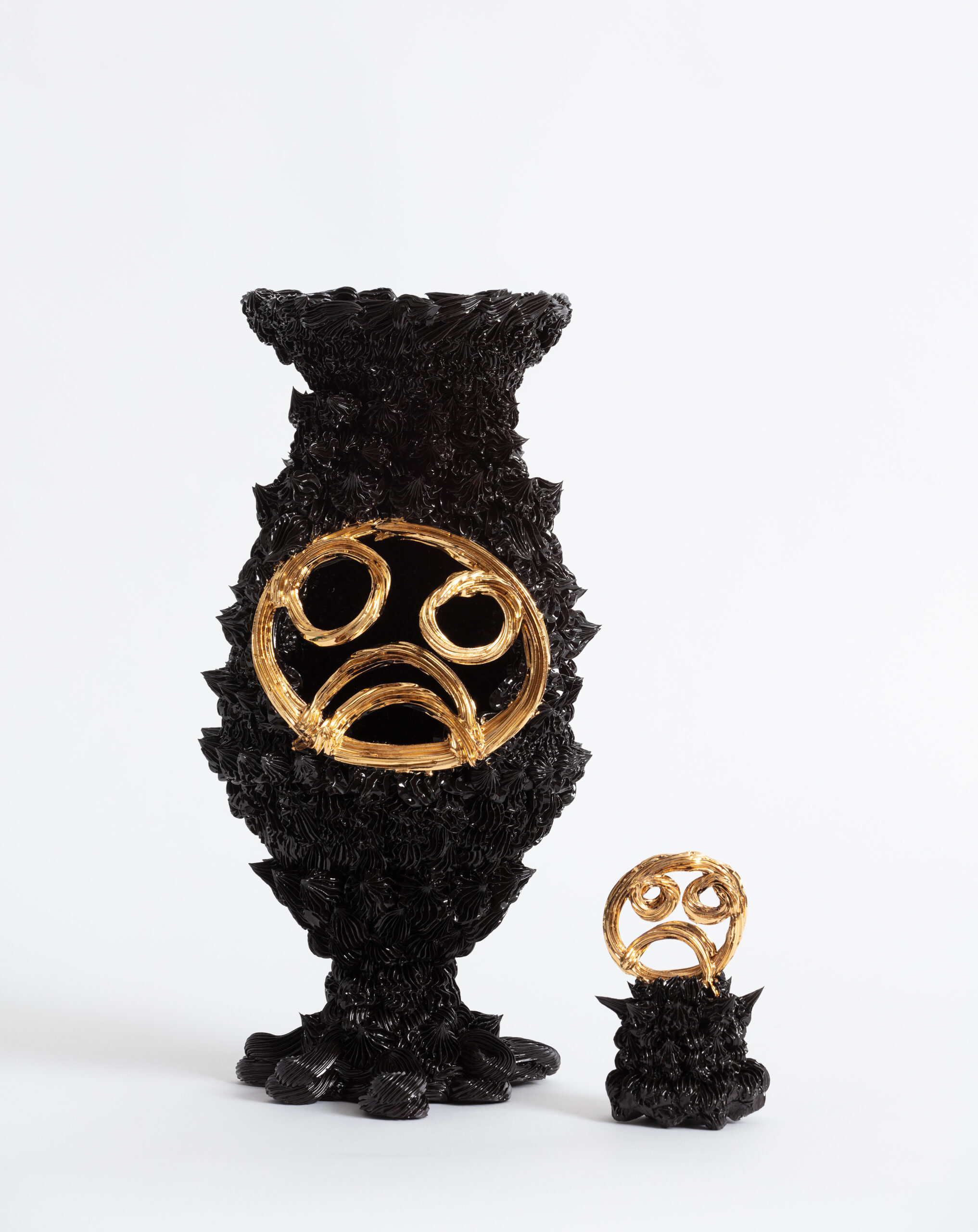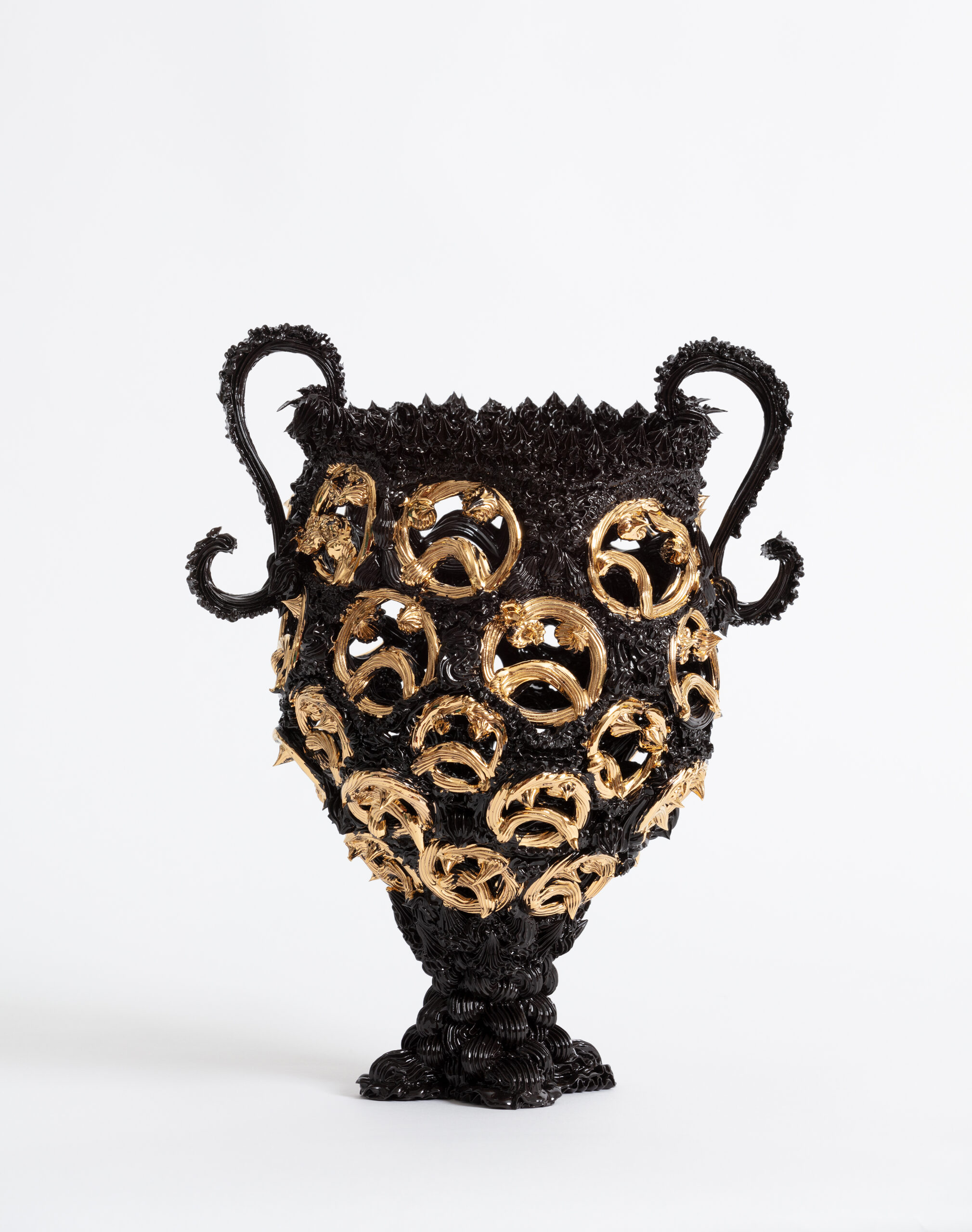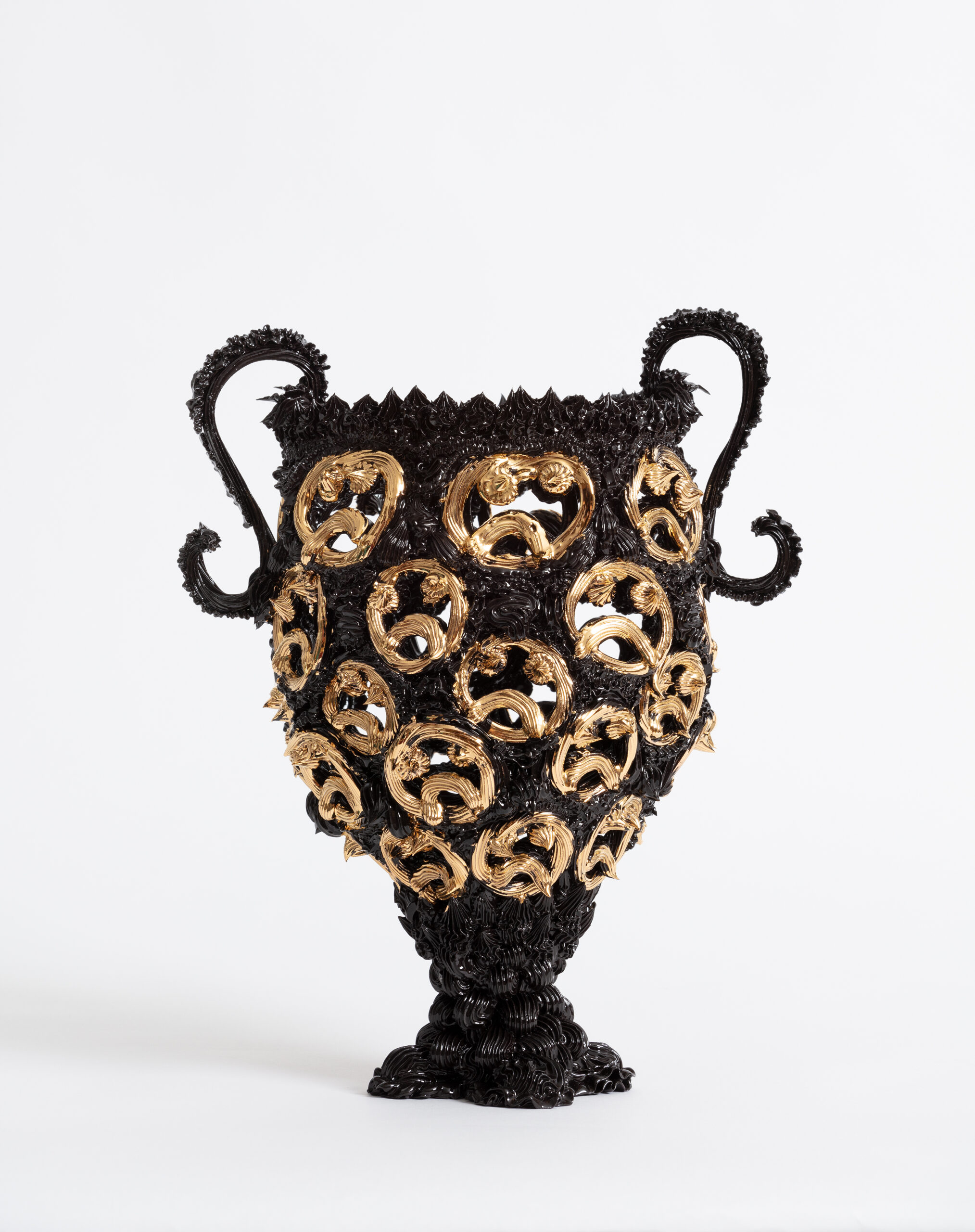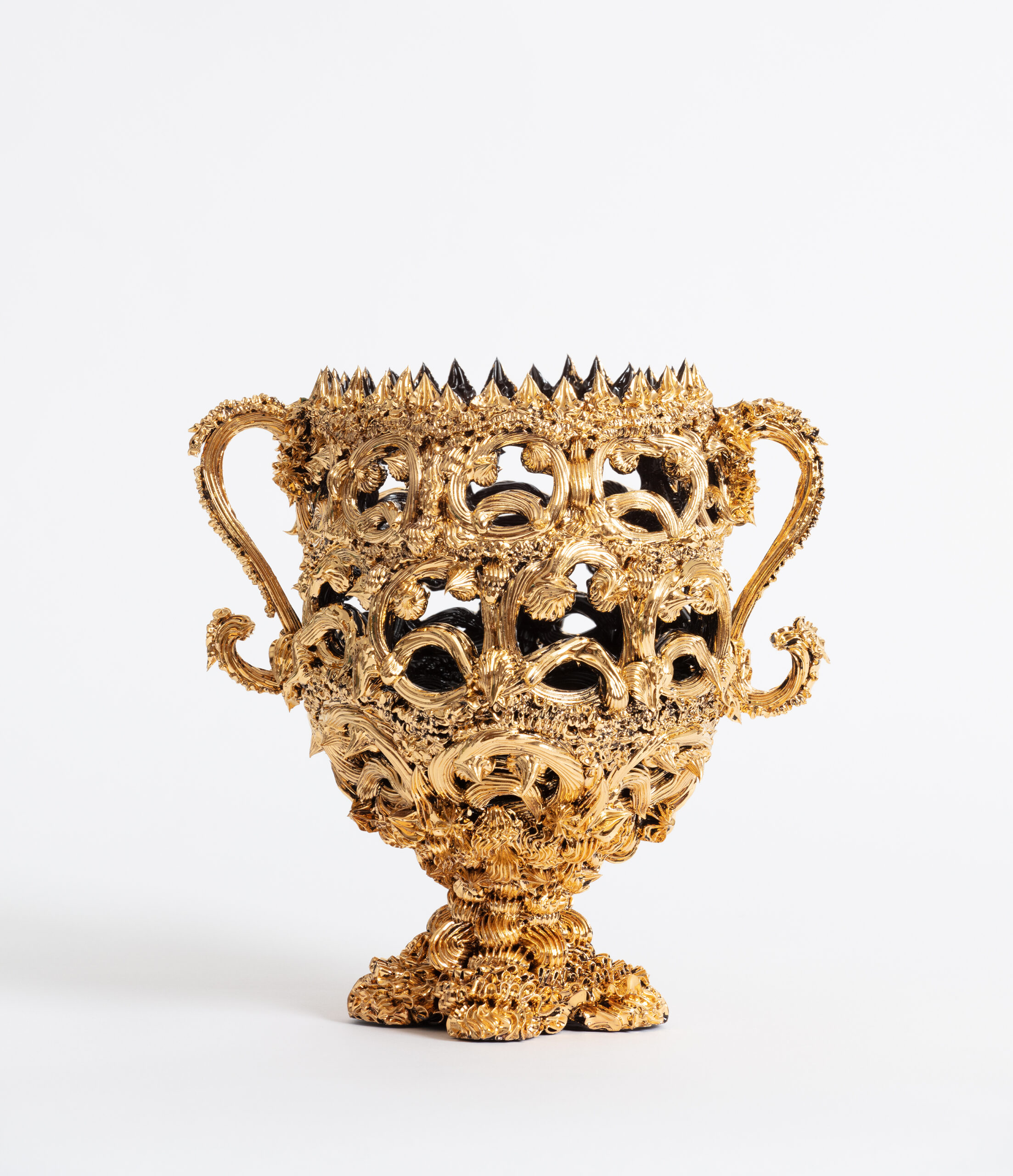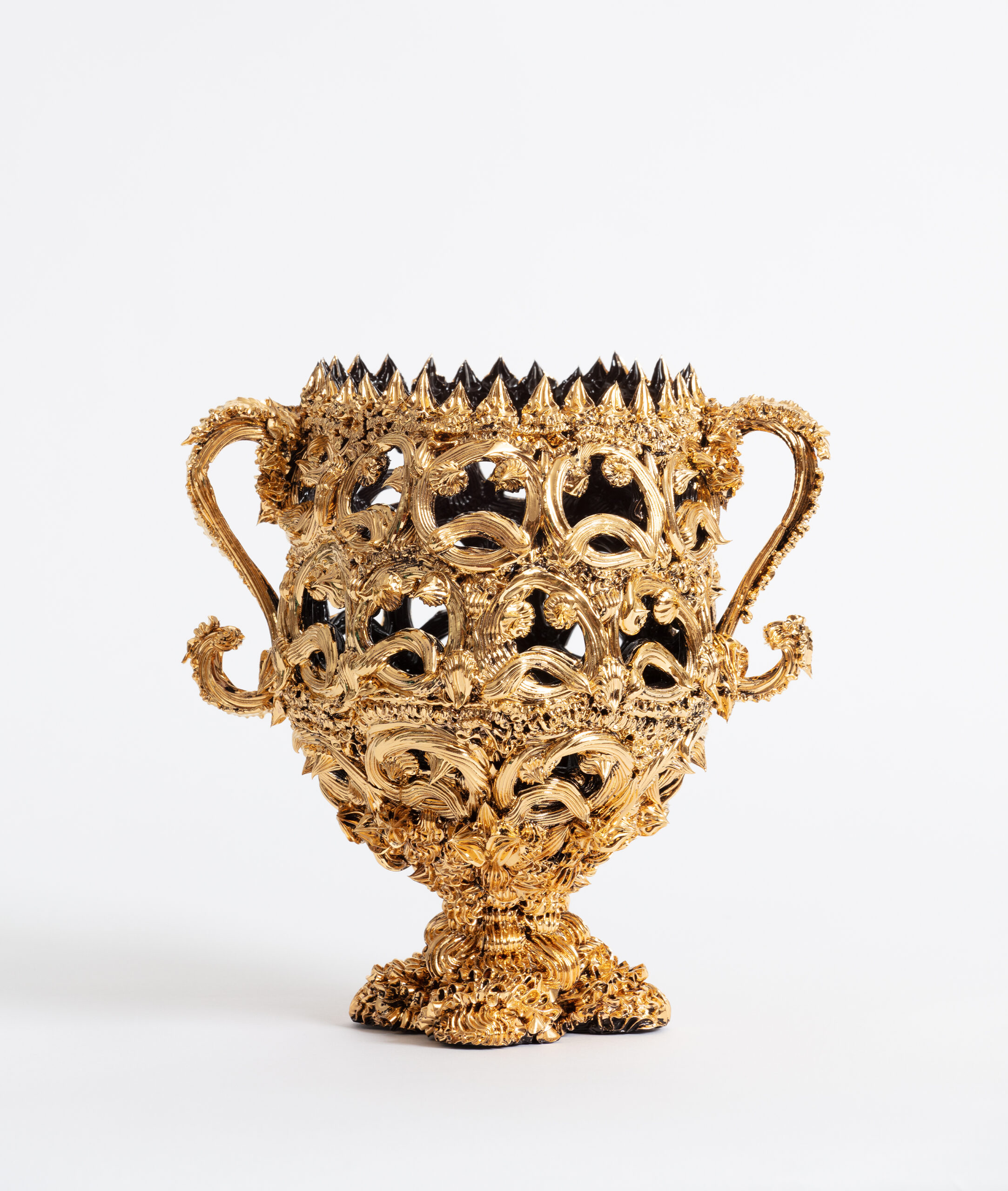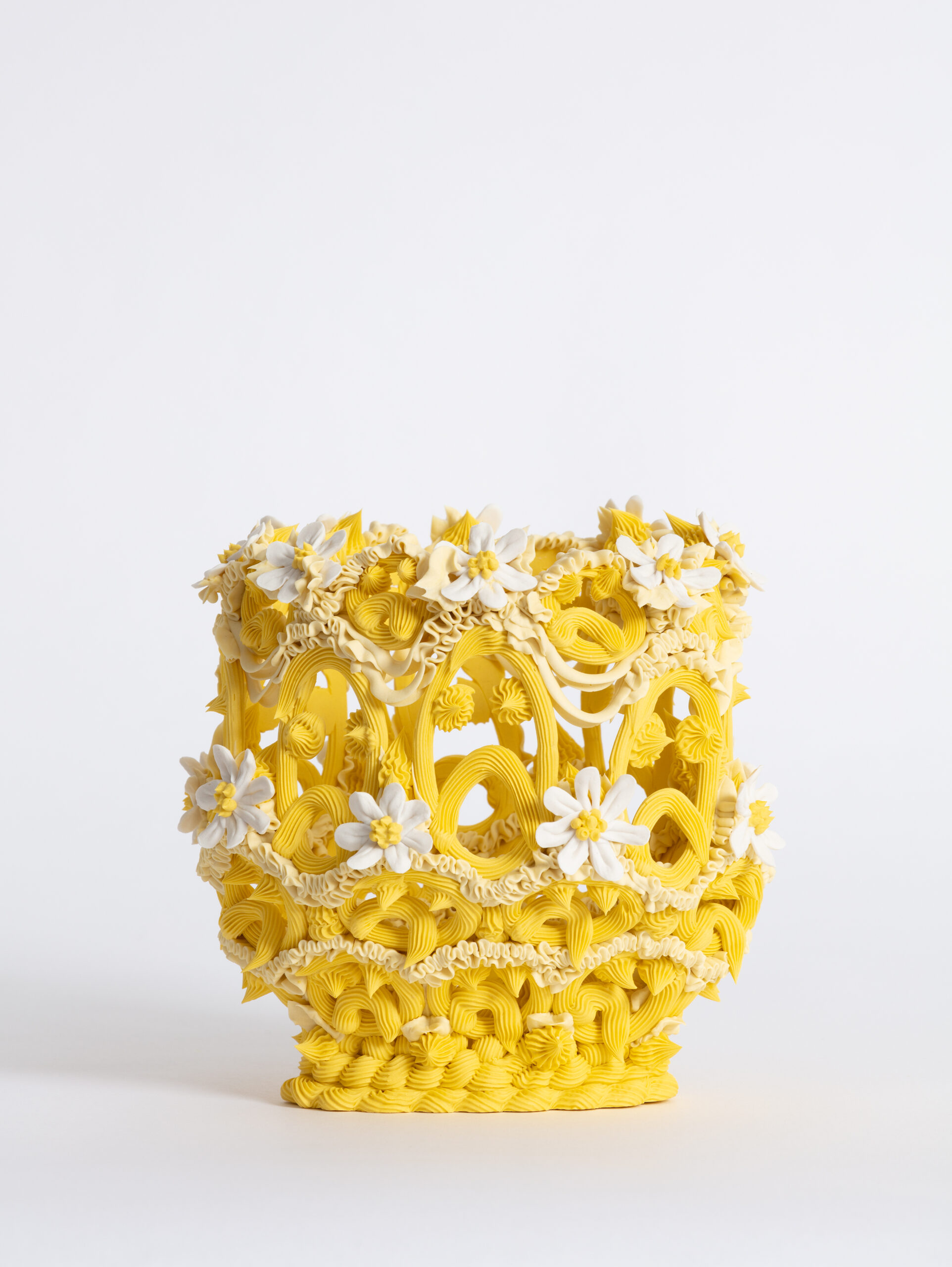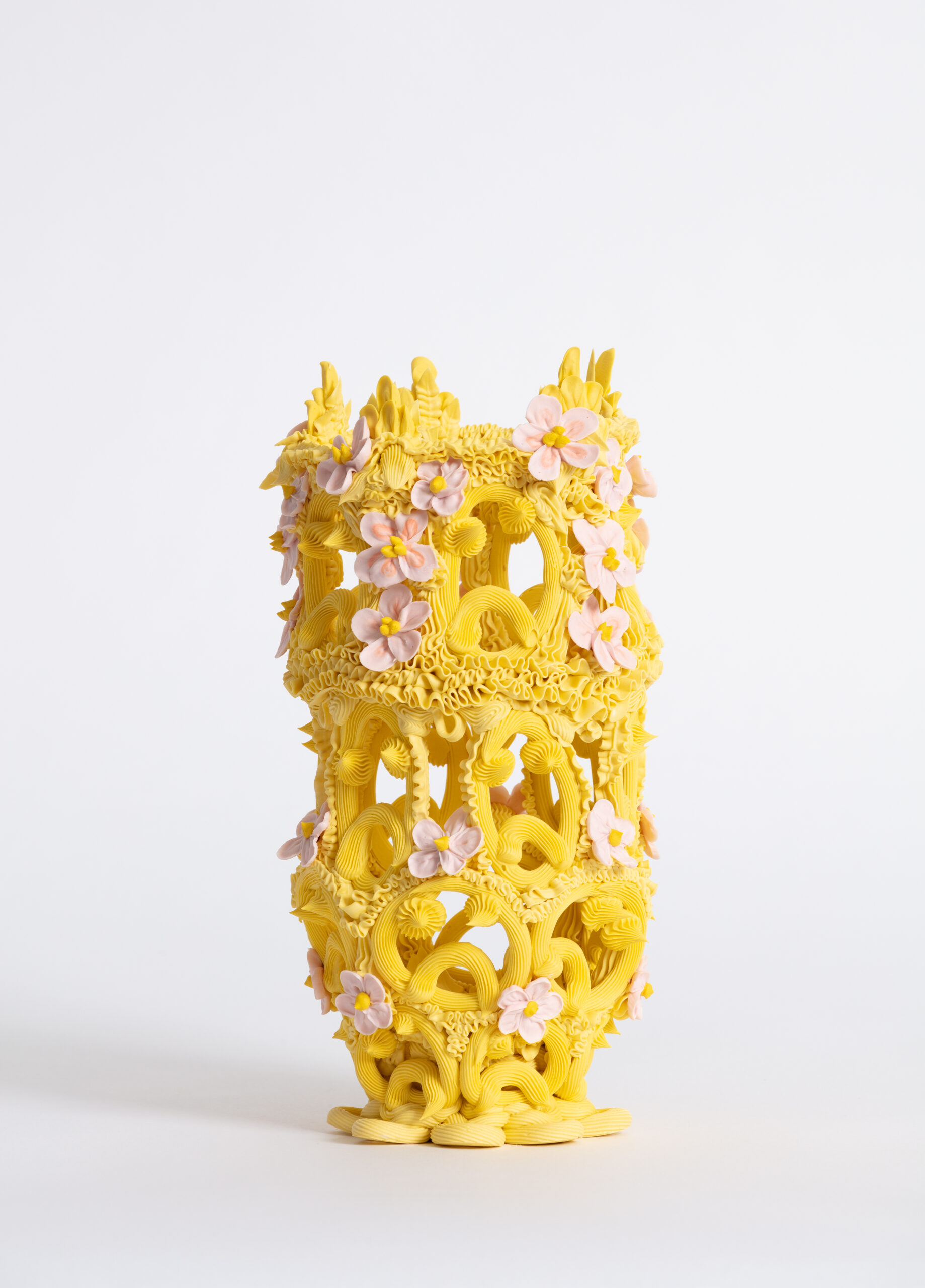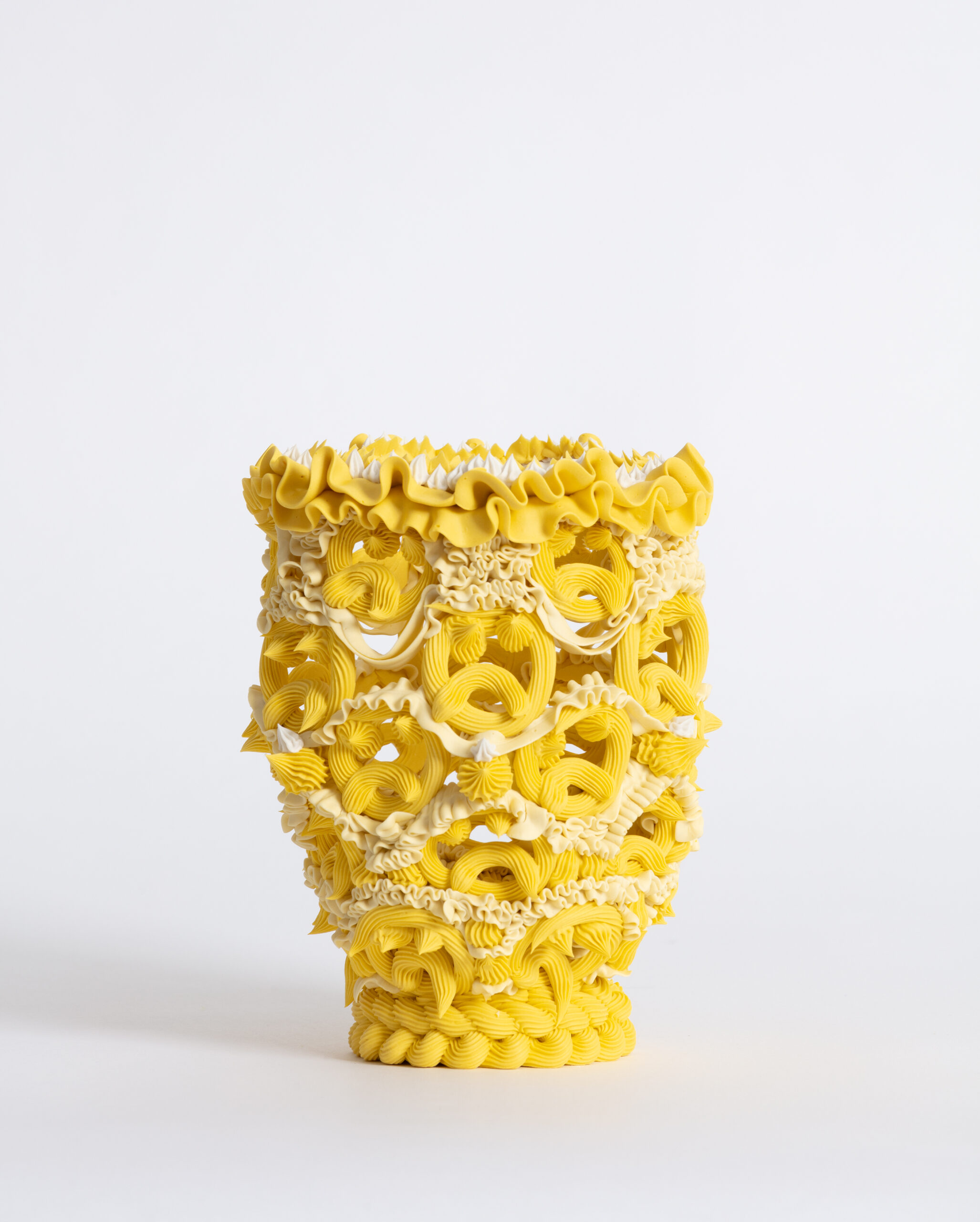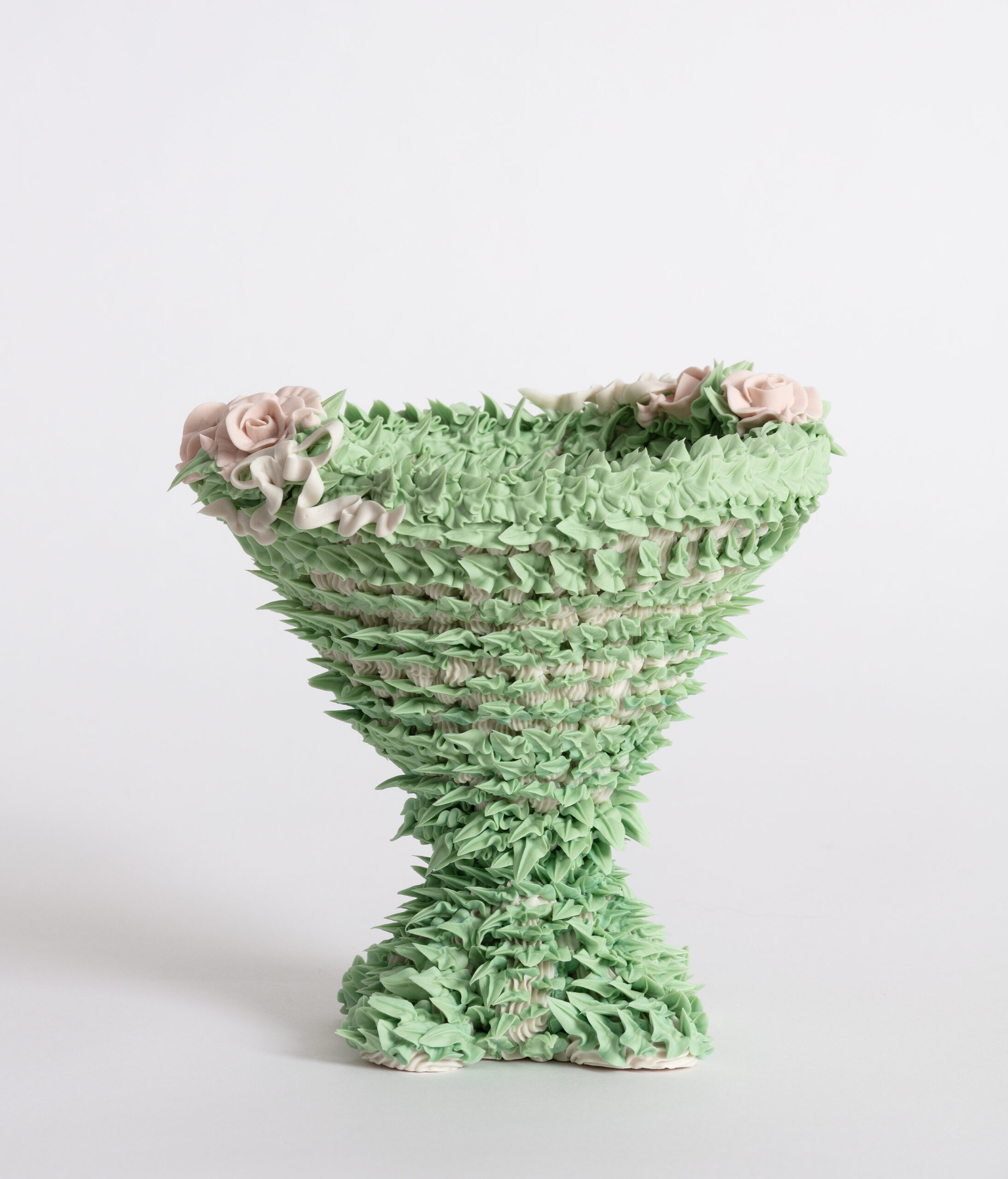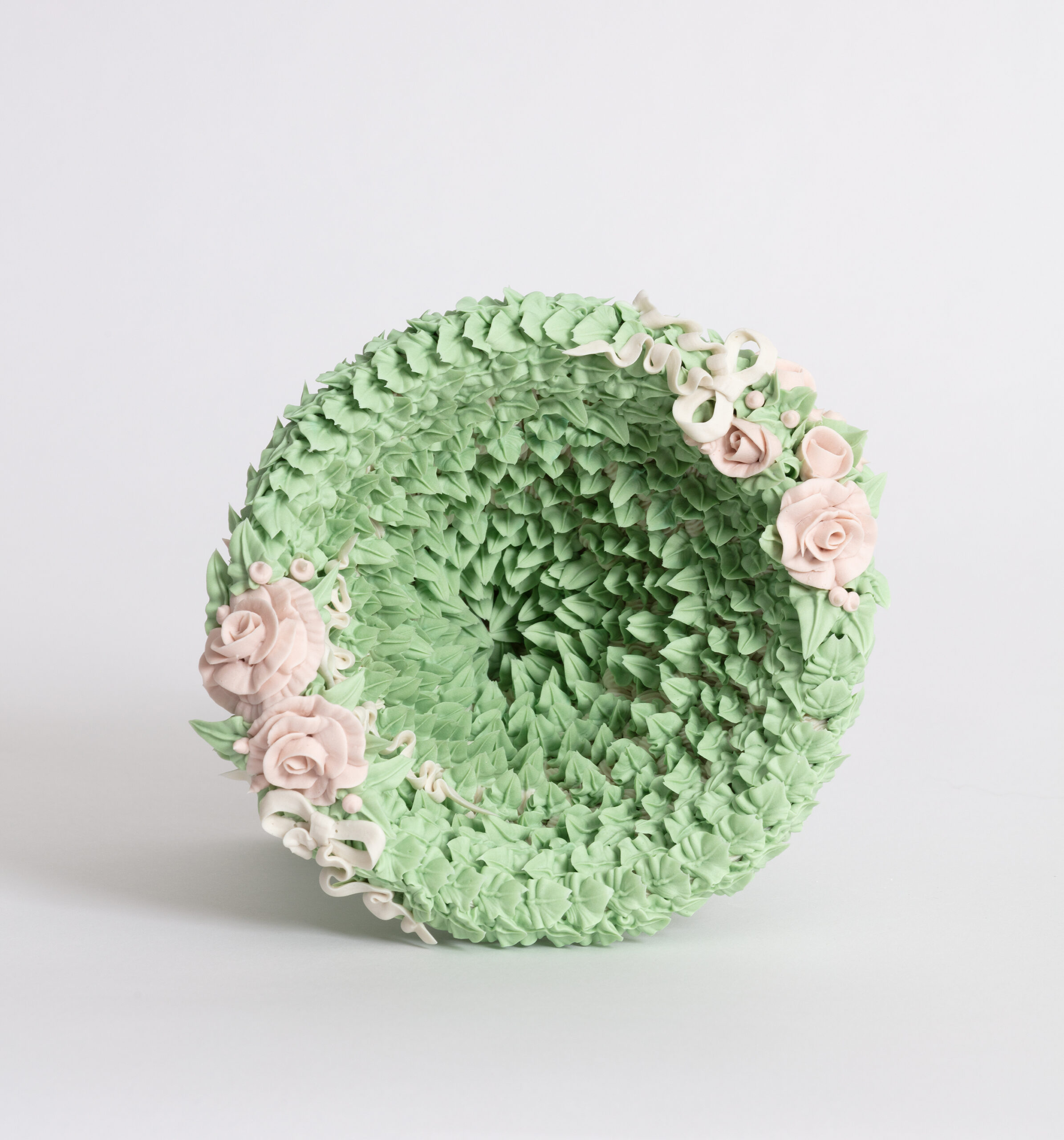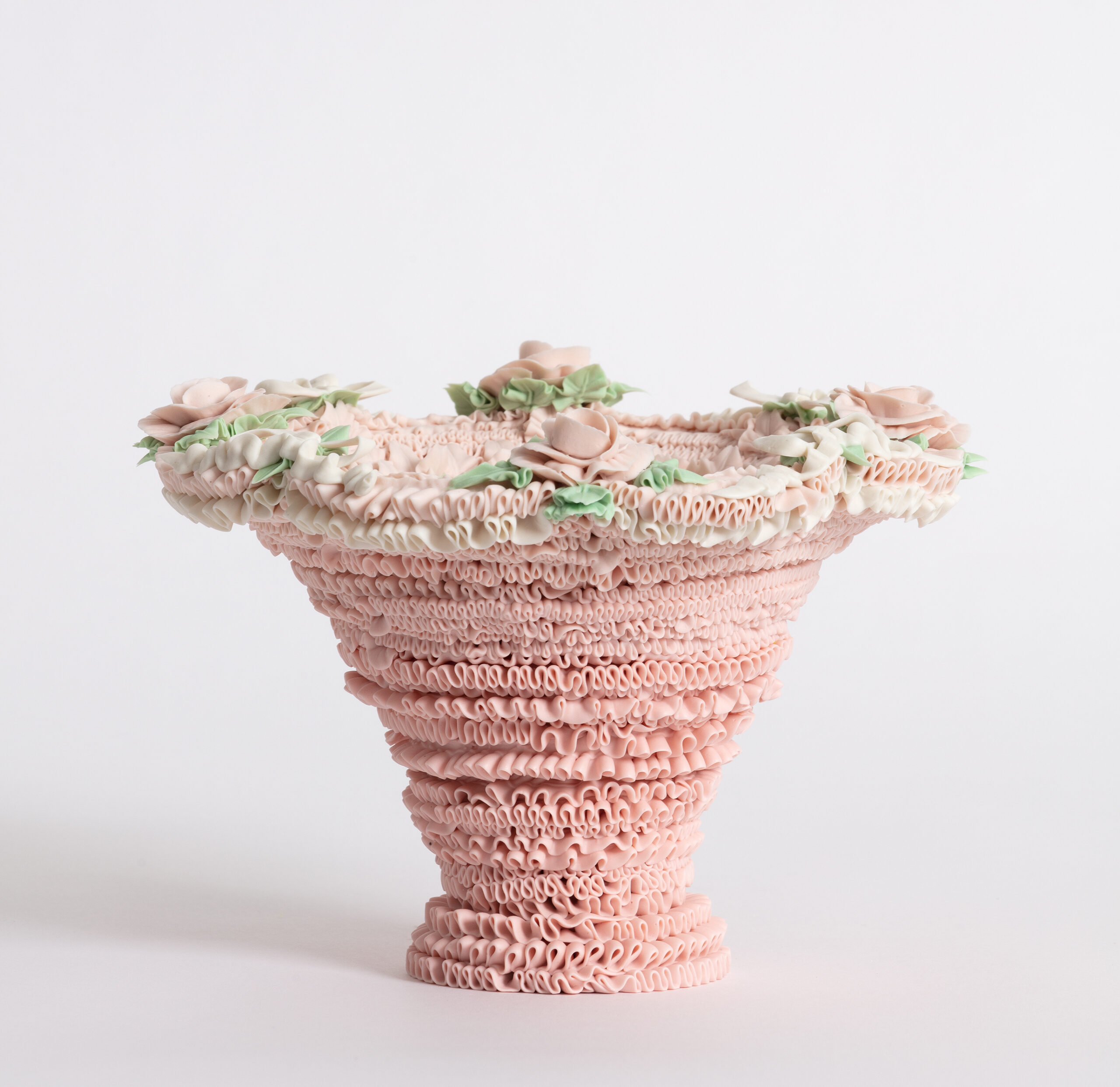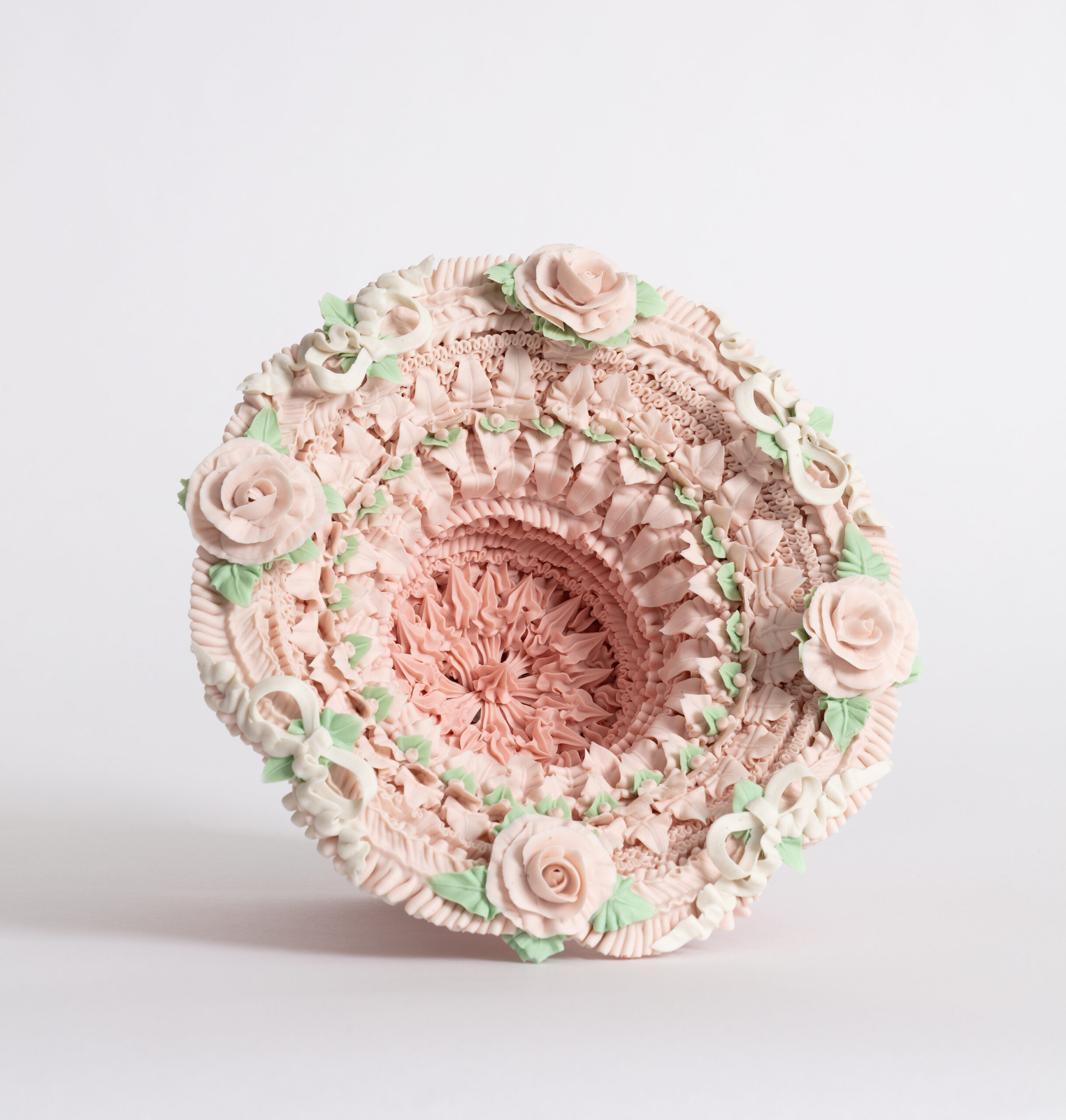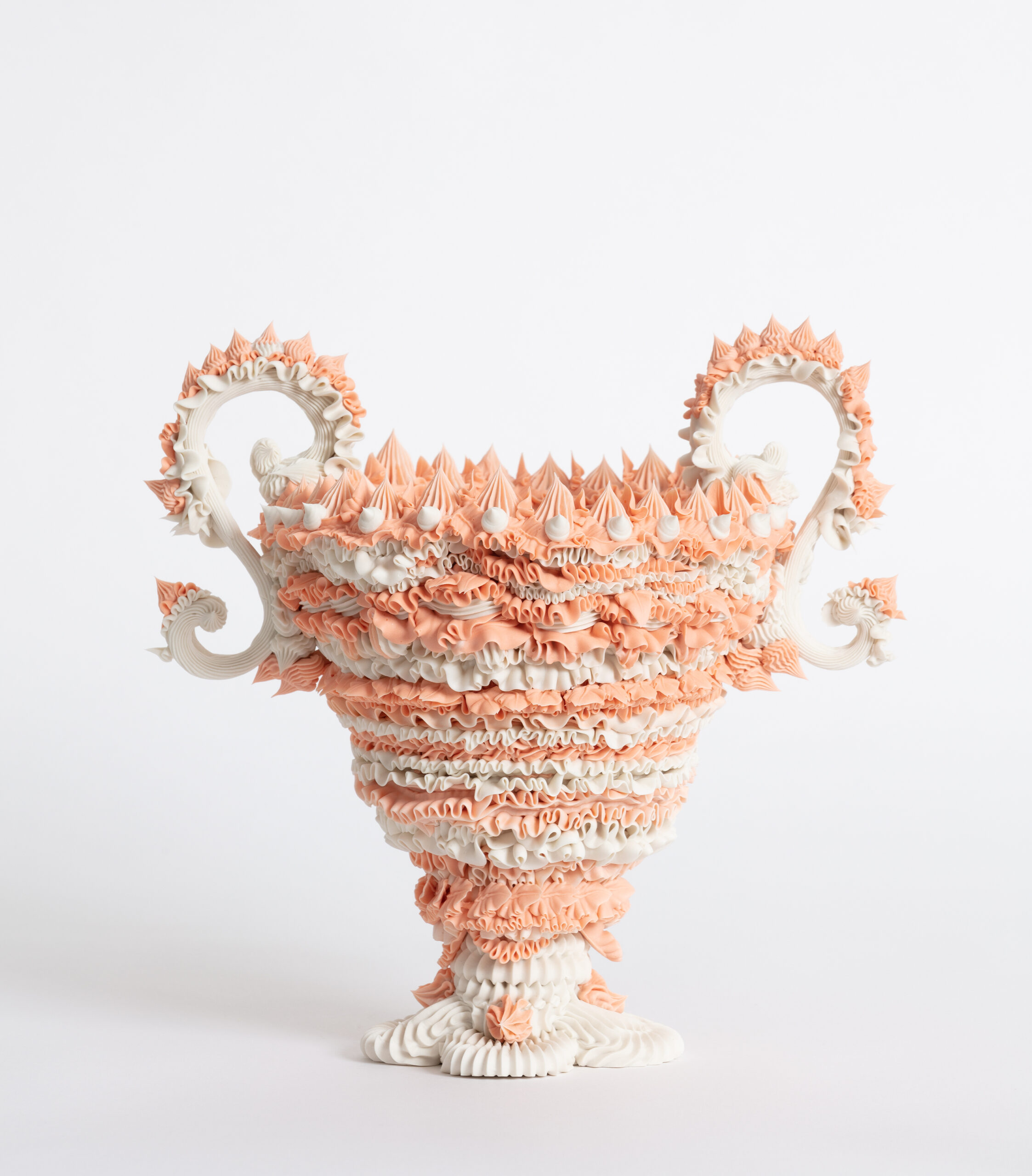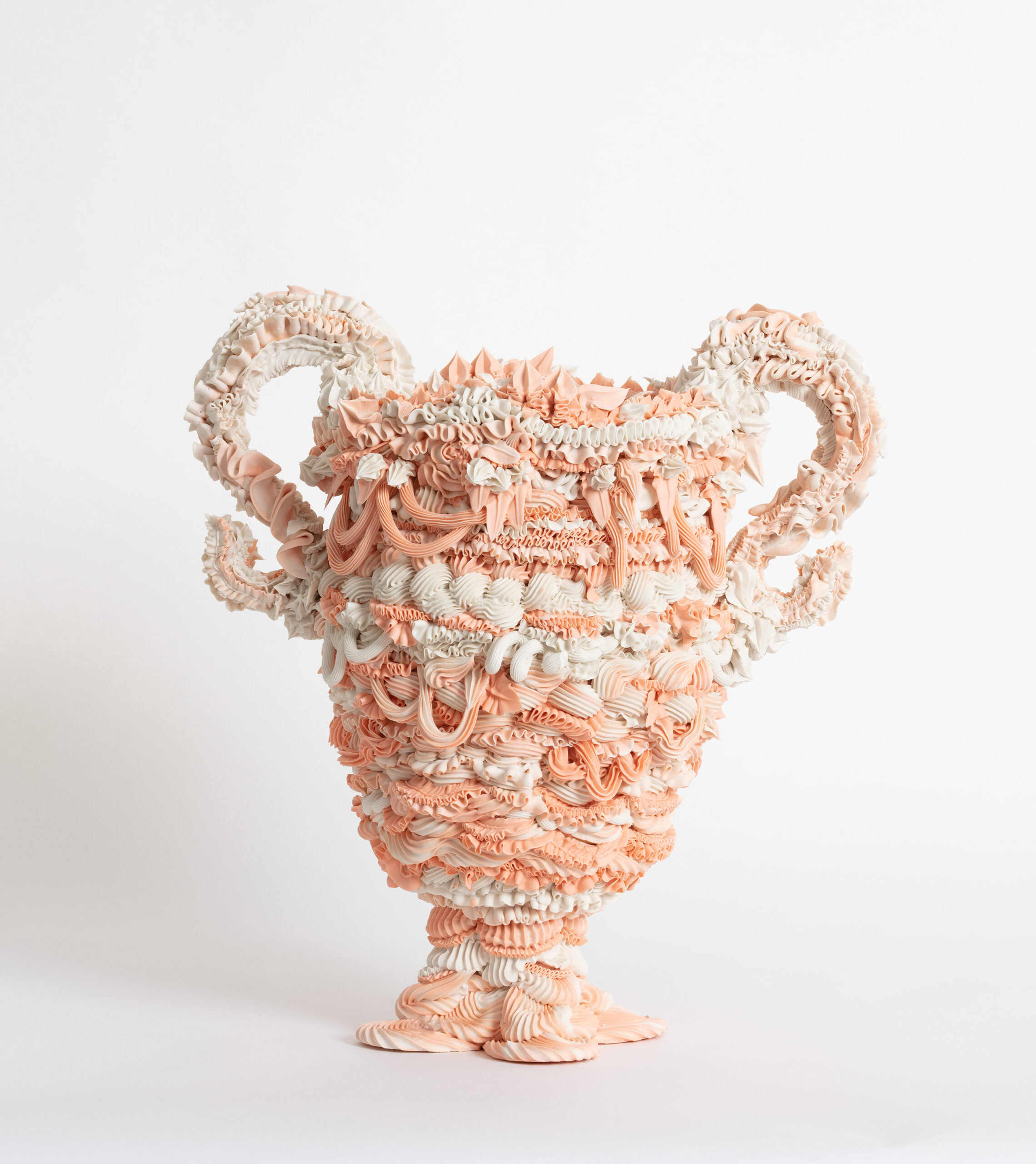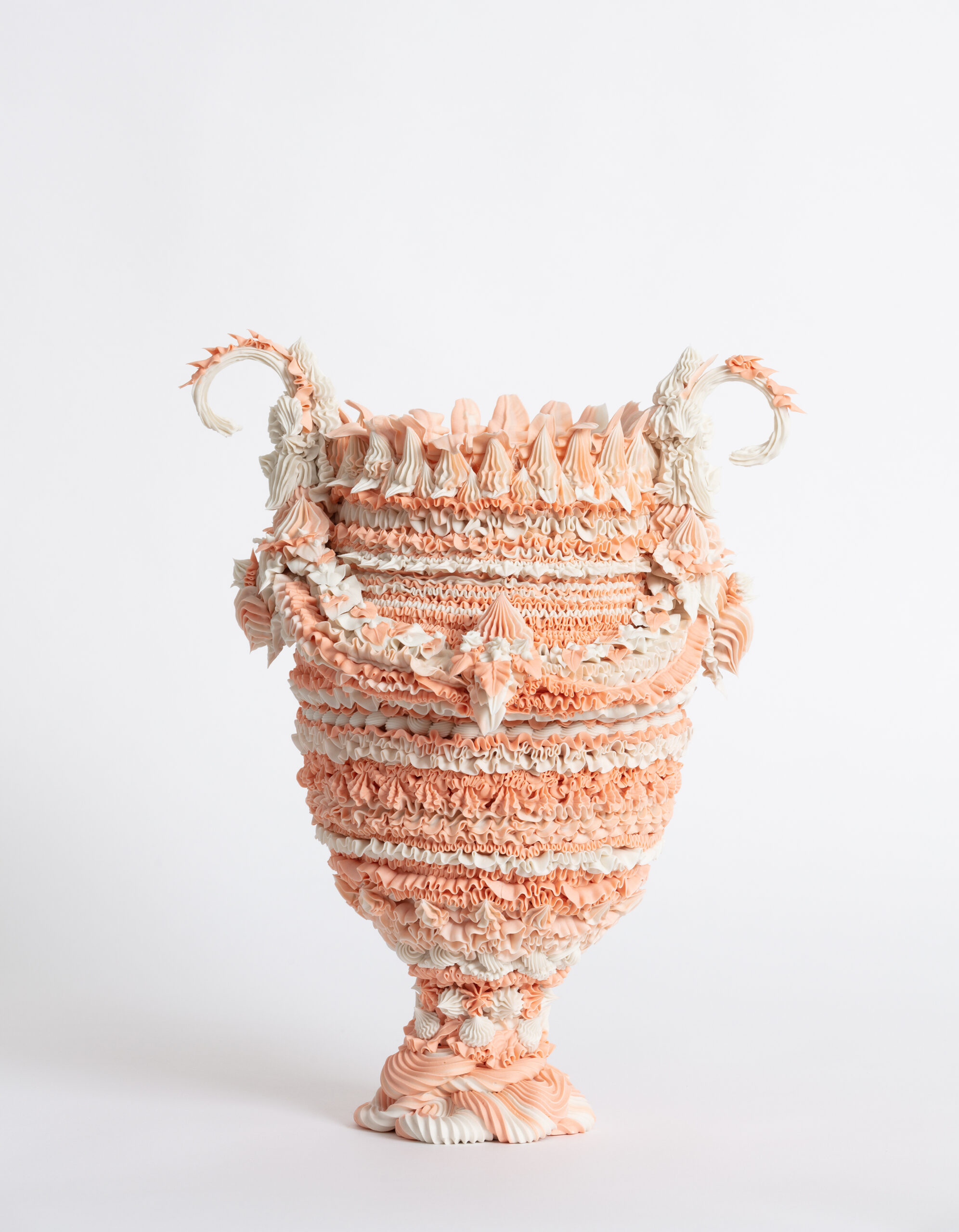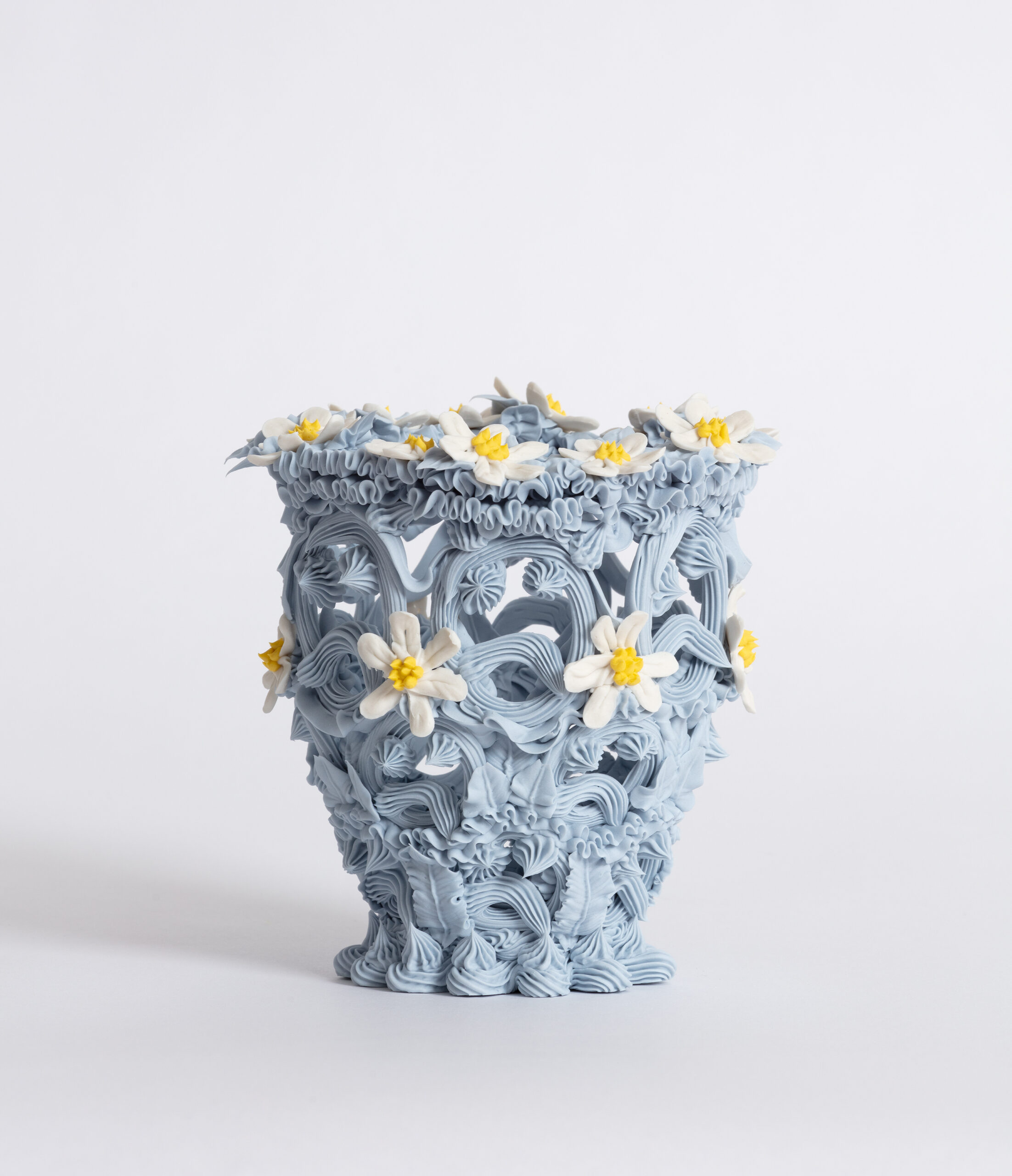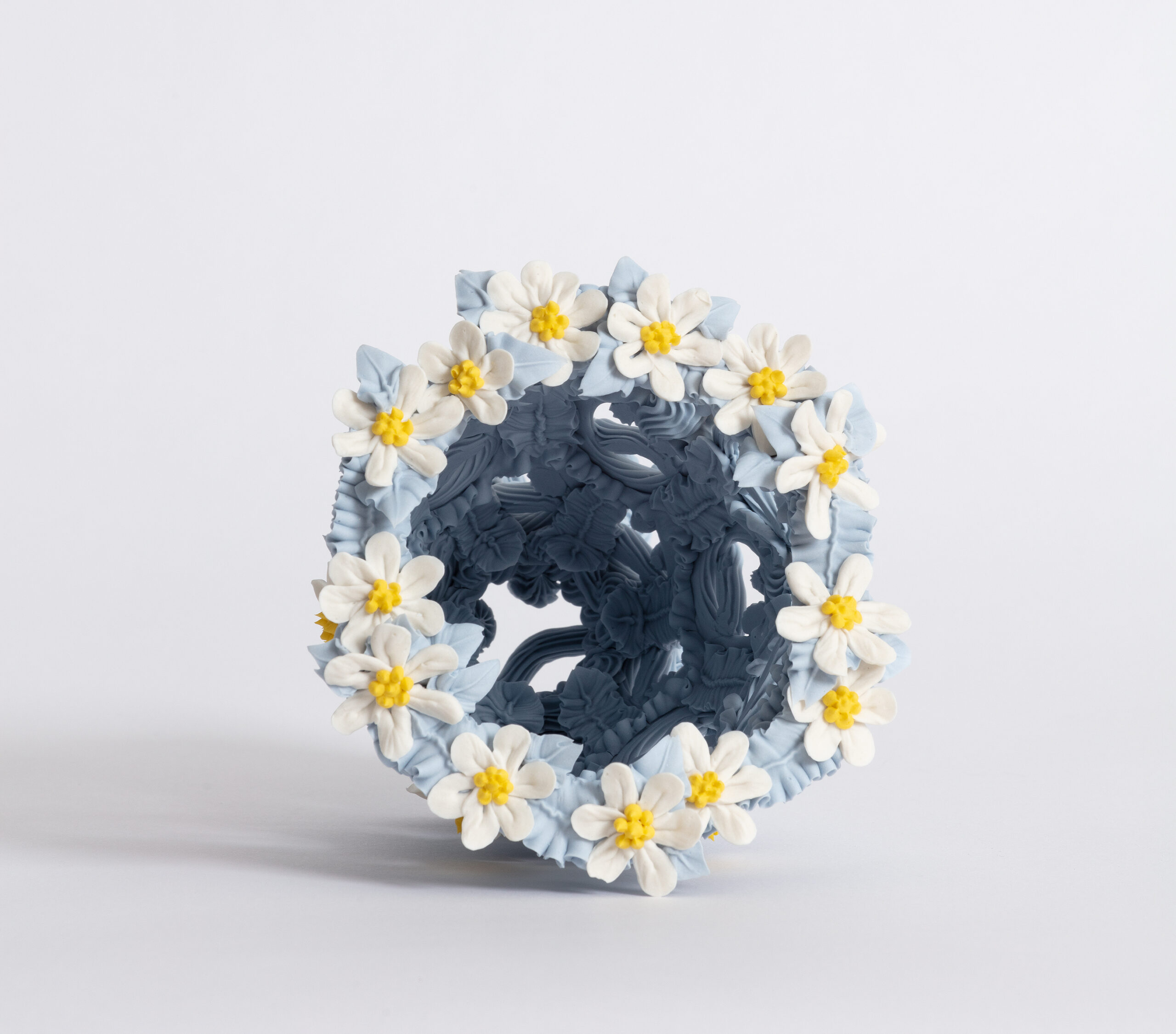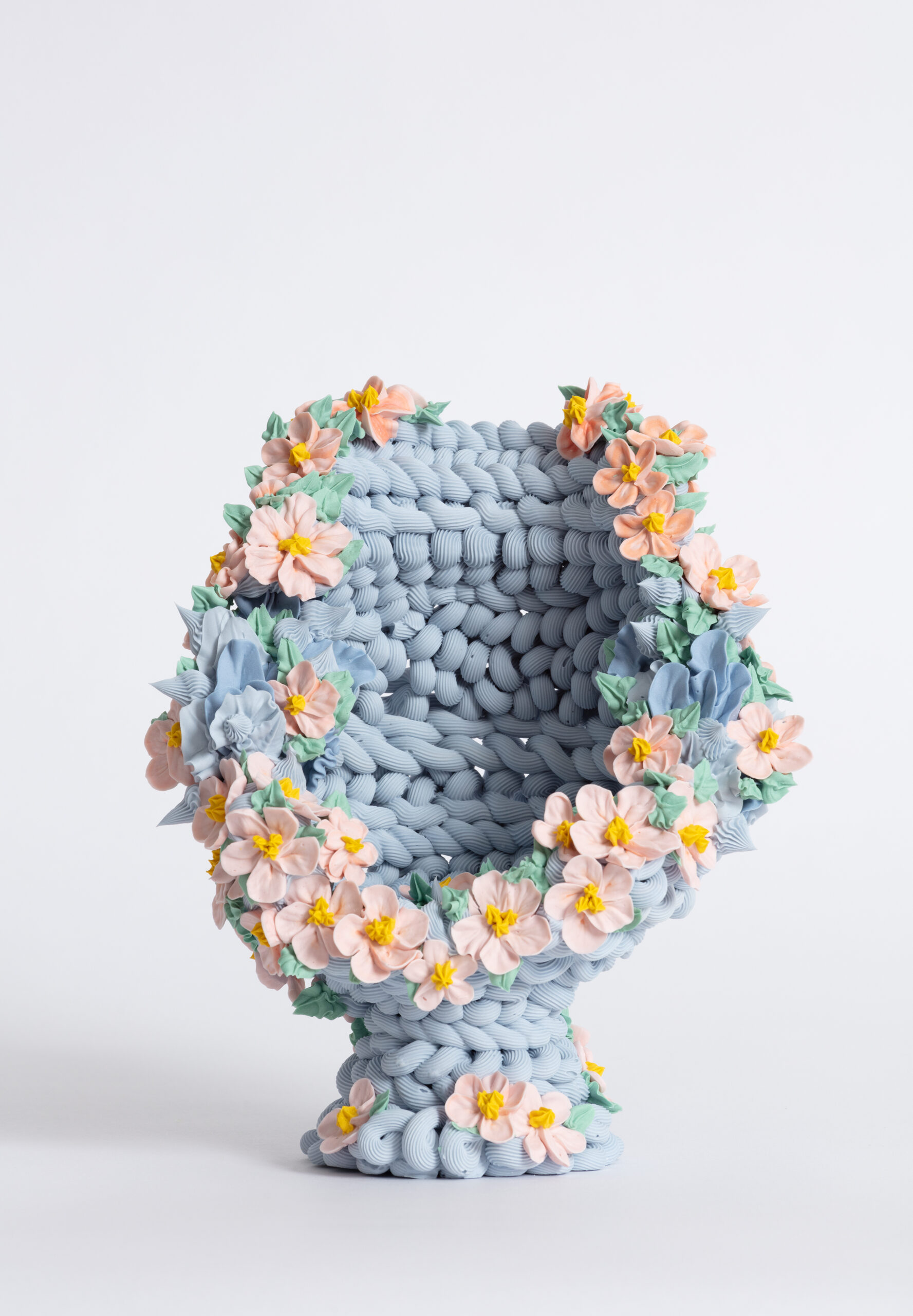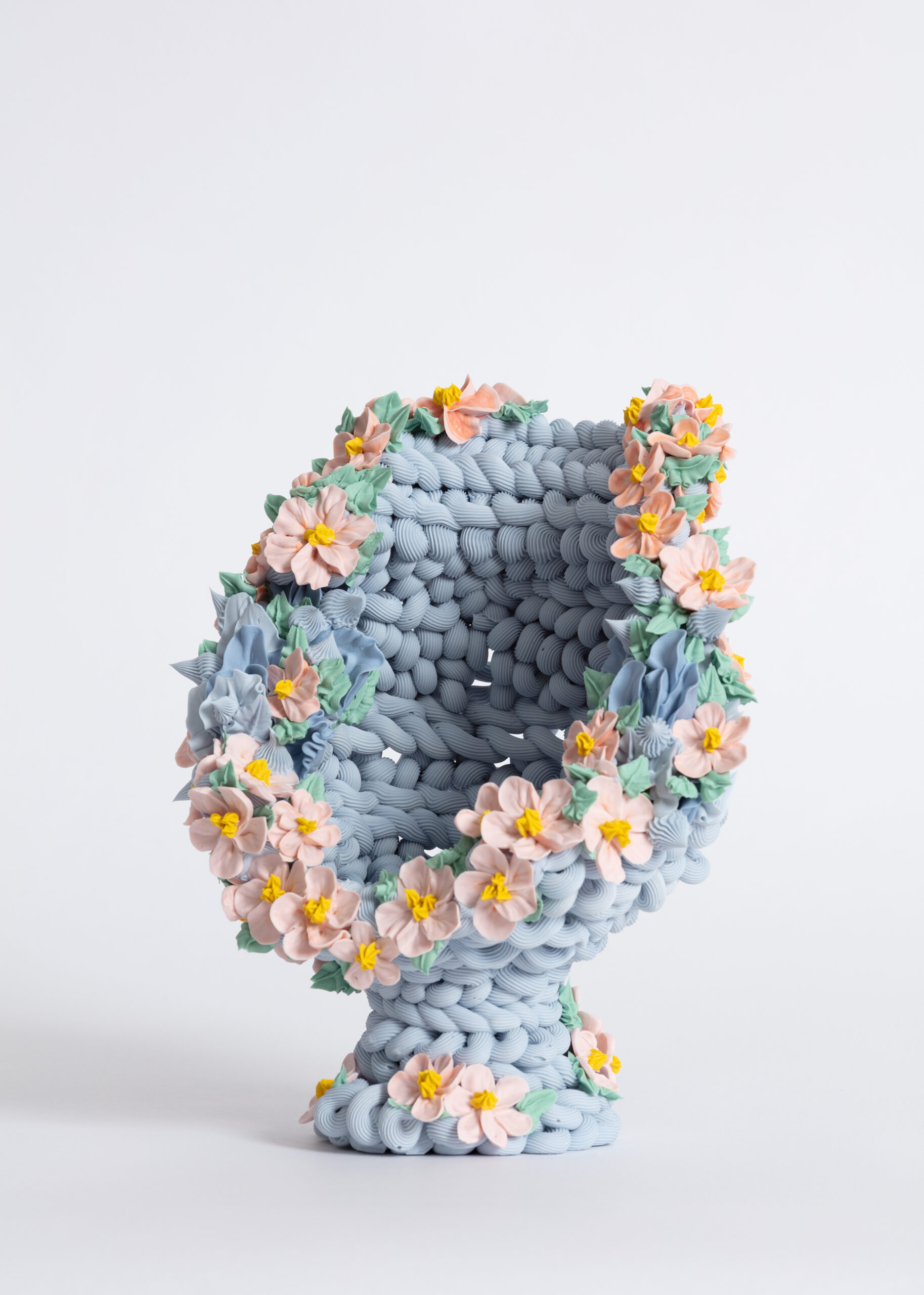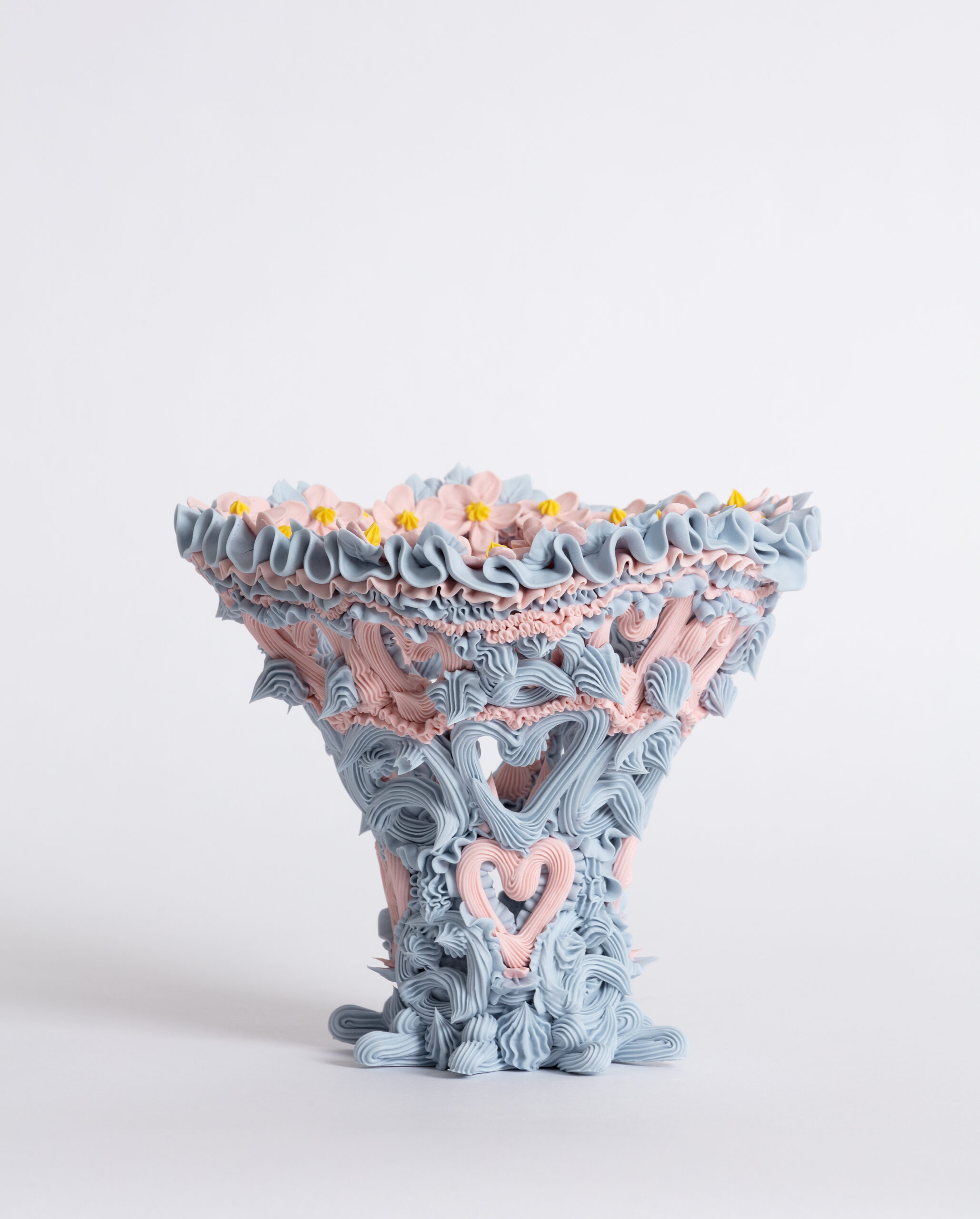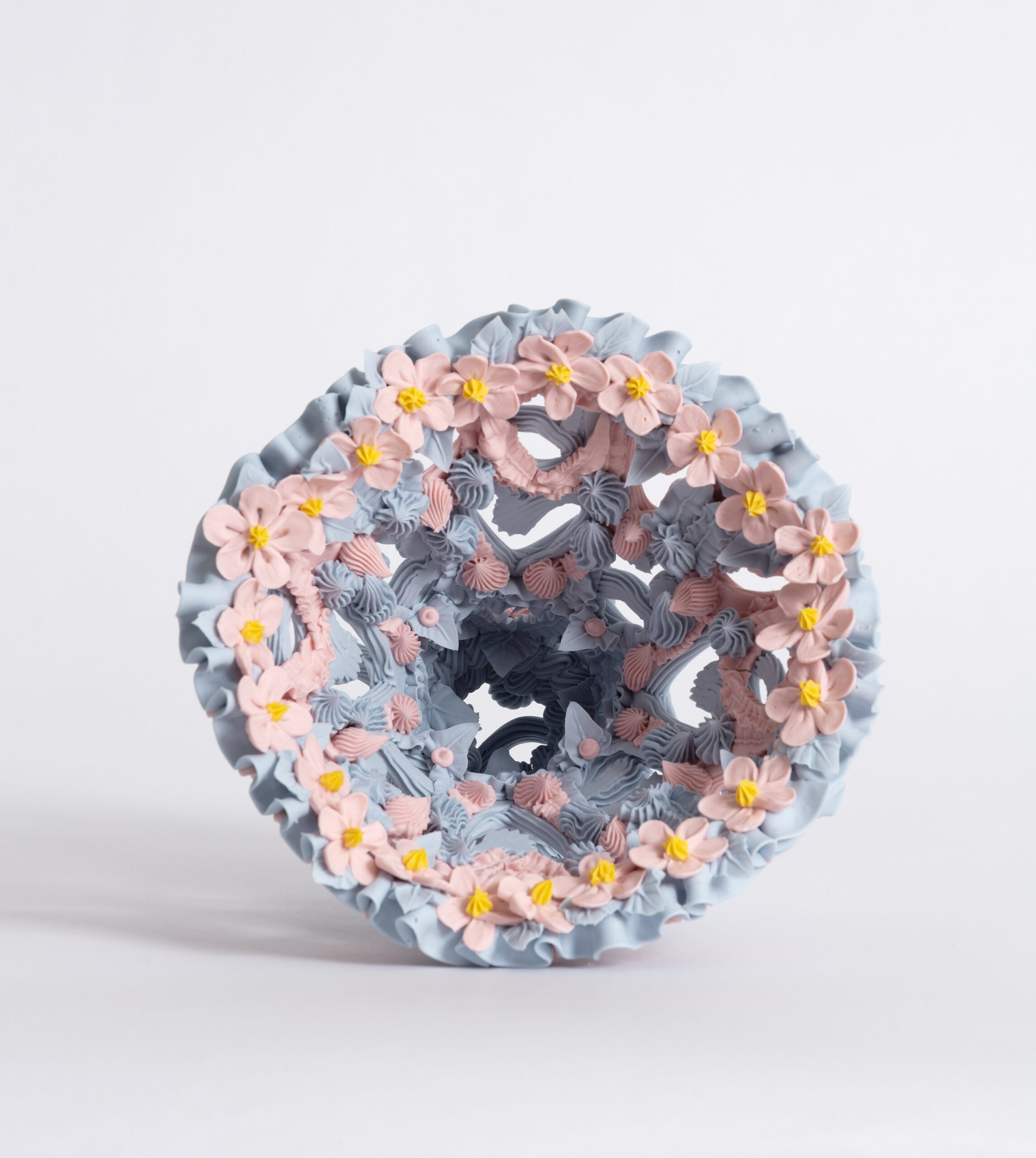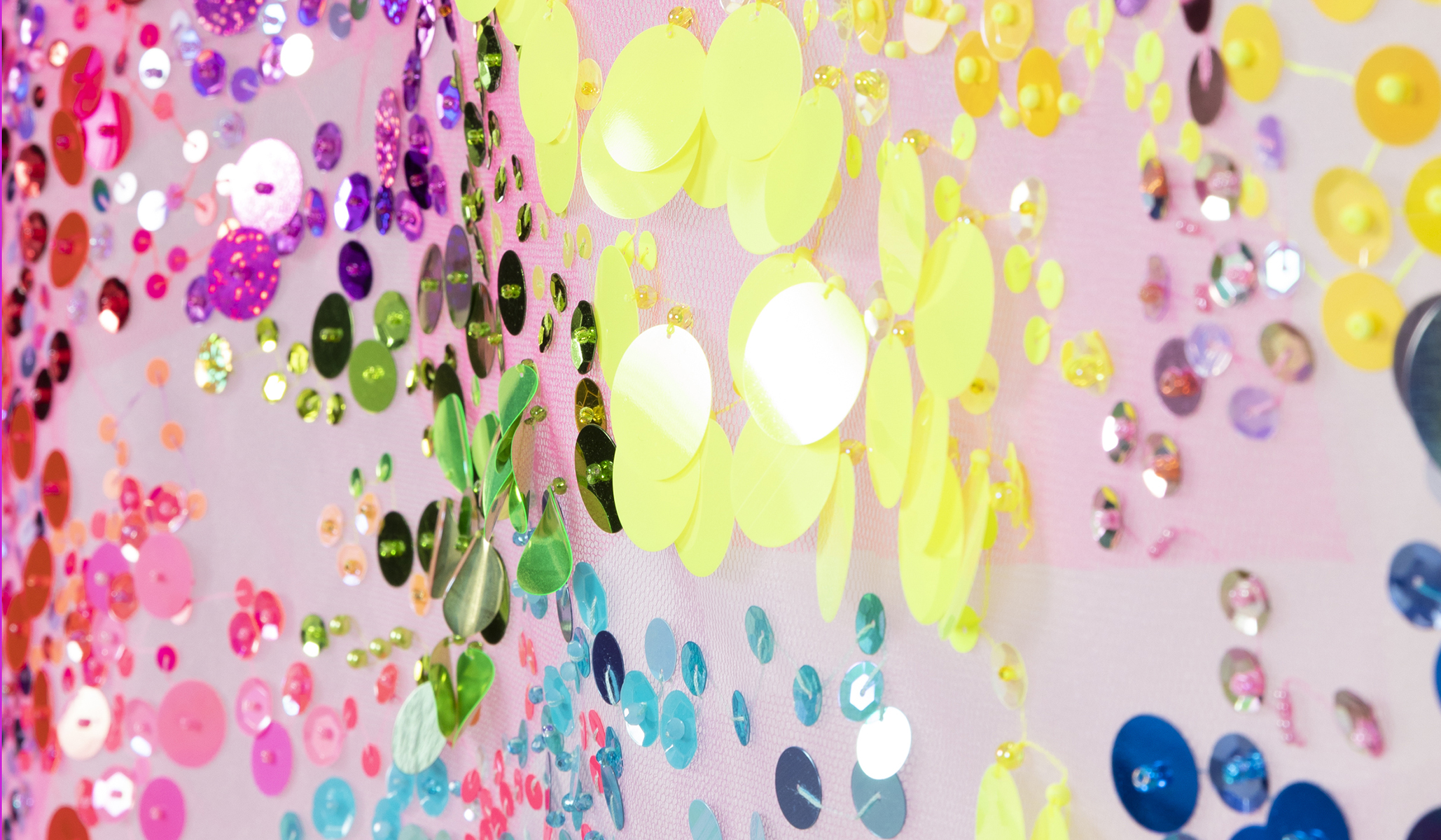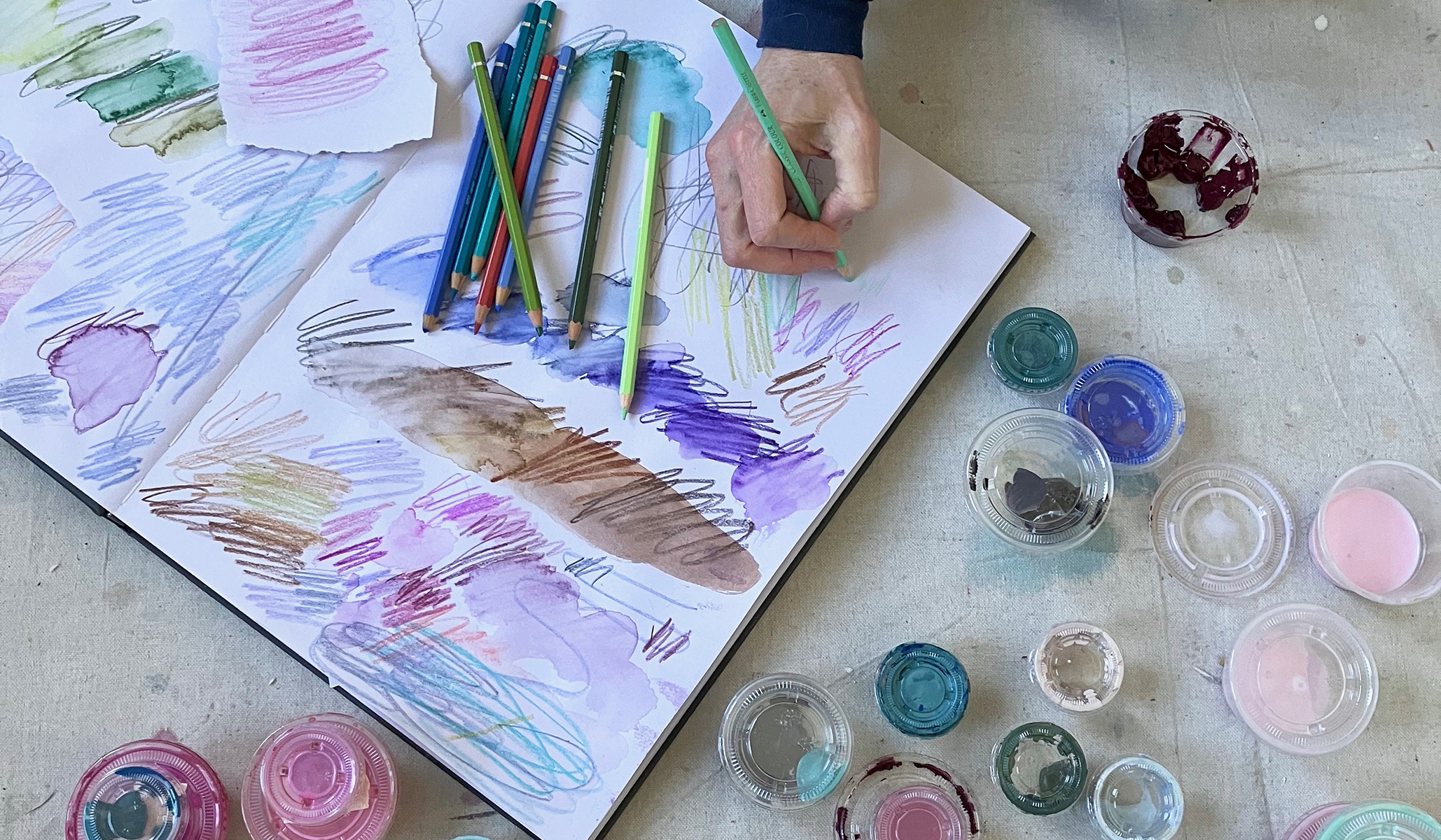Artereal Gallery is pleased to present a solo exhibition of new works by Sydney-based artist Ebony Russell. Having established a reputation with lightning speed, as one of the new generation of experimental ceramicists pushing the boundaries of the medium further and further into the realm of contemporary art, Ebony Russell is well known for her decadent, ostentatious and overtly feminine ceramic creations.
Having experienced a meteoric few years defined by a flurry of awards and inclusions in major exhibitions, Ebony Russell has received acclaim and recognition for the following accolades: Winner of the 2022 Meroogal Women’s Art Prize and Winner of the International Franz Rising Star Award for excellence in porcelain, which resulted in a residency in Jingdezhen, China in 2019. More recently her work has been included in the major exhibition Clay Dynasty at the Powerhouse Museum in Sydney with a series of commissioned pieces now forming part of the museum’s permanent collection. Her work was also recently acquired for the Bendigo Art Gallery’s permanent collection.
.
To view and purchase artworks from this series scroll to the end of this webpage or visit the gallery between 21 October – 19 November.
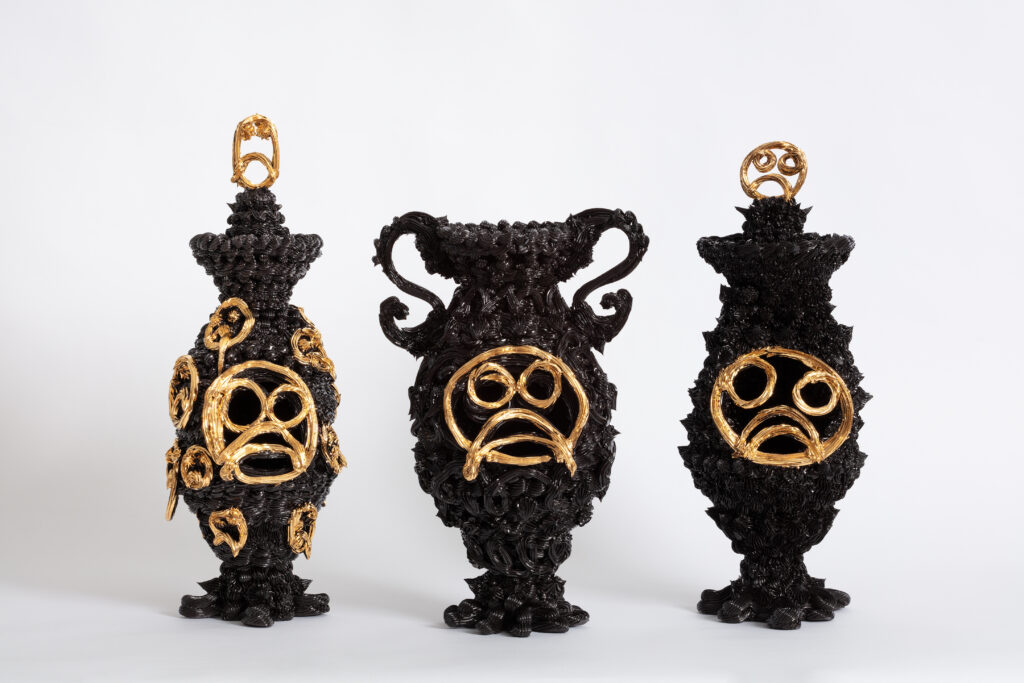
In 2020 Ebony Russell created a pair of urns. One pink and one blue. Painstakingly and intricately piped from porcelain, the urns were heavy with an abundance of frills and bows and spiky undulations. Decadent and over the top, the urns spoke of an untapped potential within the practice of an emerging artist fast establishing a cult following for creating experimental ceramic works with a feminist undercurrent. Constructed layer by layer using cake decorating techniques, they oozed an artistic sensibility that can only be described as girlish excess – meets sugary sweet kitsch – with a dash of sarcasm thrown in for good measure.
The urns were magnificent.
In 2021, off the back of these masterpieces, Russell was commissioned to create two new artworks for the Powerhouse Museum’s monumental exhibition Clay Dynasty. As part of this commission, the artist was invited behind the scenes of the museum and given the opportunity to explore the institution’s extensive historical ceramic collection. The idea was that Russell would immerse herself in this treasure trove and then create new artworks in direct response to the pieces in the museum that piqued her interest the most. The ceramic piece that Russell chose to create work in response to was a majestic 18th century Wedgewood vase, executed in the maker’s iconic blue and white jasperware.
And so Ebony Russell began to create vases. And urns. And chalices.
In writing about the artwork she ultimately created for the Powerhouse Museum, Russell stated that ‘the vase embodies the tension between the highly regulated architectural language of neoclassicism – composed of a harmonious balance of rectilinear and curvilinear form – and the oozing decadence of an ephemeral confectionary fantasy. Over excessed with swags, bows, ribbons and rosettes my work highlights the continued ghettoisation of women’s work in traditional art histories, most especially around ceramic practices.’
Fast forward to October 2022, and Ebony Russell’s latest solo exhibition DE•CORUM features new works that have continued to grow out of the artist’s now borderline-obsessive interest in urns and the symbolism associated with these decorative vessels. Included in the exhibition are a new series of blue and white urns, many of which bend and lean in to each other as though caught mid-conversation. There is a hint of something magical about these works. They have an almost anthropomorphic quality… Shown alongside these Wedgewood inspired blue and white pieces, Russell also showcases a series of licorice hued vases, so decadent that you can’t help but be drawn in by them, despite the fact that they are bittersweet with their smattering of sad faces.
The artist elaborates on these pieces, explaining…
“My art practice embraces decoration without decorum. My urns and pots are not happy – refusing to play to the feminine mainstay, they will not smile for you. They are frilly and decorative and overly embellished. Saccharine layers dripping in gold tears, embellished with roses and bows. Puffy-sleeved with hands on hips, they unapologetically express themselves, frowning with their disapproval.
While my own childhood memories and daydreams heavily informed my colour palette, I am reminded in my present interests too, of how colours are coded to speak to the underlying, heavily gendered and classist messaging we receive from them and the juxtaposition they create.
The sky-blue hue of Cinderella’s Disney gown and the pastel blue colour palette overwhelming the interiors, dresses, and waistcoats of the hit Netflix series Bridgerton spring to mind – these dreamy, decadent hues of decency, taste and good breeding.
They are sharply contrasted with Cinderella’s ugly step sisters and the Featherington daughters, sharing garishly bright, patterned, and overly embellished costumes, the essence of indecorum. My recent work with the perfect jasperware blue, the quintessence of Wedgwood’s ceramic production, may have had something to do with the association that lingered here. As I attempted to recreate this colour, I pondered this notion.”
Emerging from a whirlwind of blue and white Wedgewood inspired pieces, Ebony Russell found herself continuously returning to thoughts on the intersection between colour, symbolism and decoration, and the way that this plays out in our lived experiences…
“In 1988, I was a bridesmaid to my aunt – I wore a peach taffeta dress handmade by my mother. Puffy sleeves, a sweetheart neckline, a drop waist embellished with a bow, and my first pair of white patent leather heels. I was eight years old, and this was my dream – to be a bridesmaid. The dress was almost as good as that of my 1984 Peaches n’ Cream Barbie Doll. My peach hued vessels mimic these dresses with their profusion of swags, ribbons, and rosettes, decorative motifs that also increased in eighteenth-century women’s fancywork, critiqued for its superficiality and excess.”
And from there the fascination with decoration continued, leading to the flurried creation of a pastel-hued body of work so saccharine sweet and floral in nature that they are at once both irresistible and just slightly garish – in the best possible way.
“Pierced openwork and reticulated trellis vases further deconstruct the romantic idyll generally presented in Rococo and neoclassical motifs tapping into an alienating and disturbing undercurrent, reflecting a general malaise or unease in society today. These pretty decorative and pretty useless objects inject a dose of discomfort. Their pointy thorns and razor sharp teeth sit alongside the flowers and pearls. The sad faces stare out of the forms unafraid or censored. They want you to see their disapproval.
Decoration generally refers to addition that accentuates. Decorum sets the boundaries of the acceptable. The aesthetic guidelines that dictate good and bad taste constantly oscillate between the whipped whimsy of fashion and the timeless continuum of a classical tradition is defined by behaviour in keeping with good taste and decency. Decorum is violated in a profusion of flowers, vinetta flourishes, and spiky protrusions. Exuberant in their indecorousness.
For me, these are not vases but illusions. I create them with no form, no structure, or architecture to hold them up or for the decoration to adhere to. It must be total decoration – anything else would destroy the fantasy. They are a mirage. Ornamentation alone. Lacking in decorum, overloaded with decoration.”
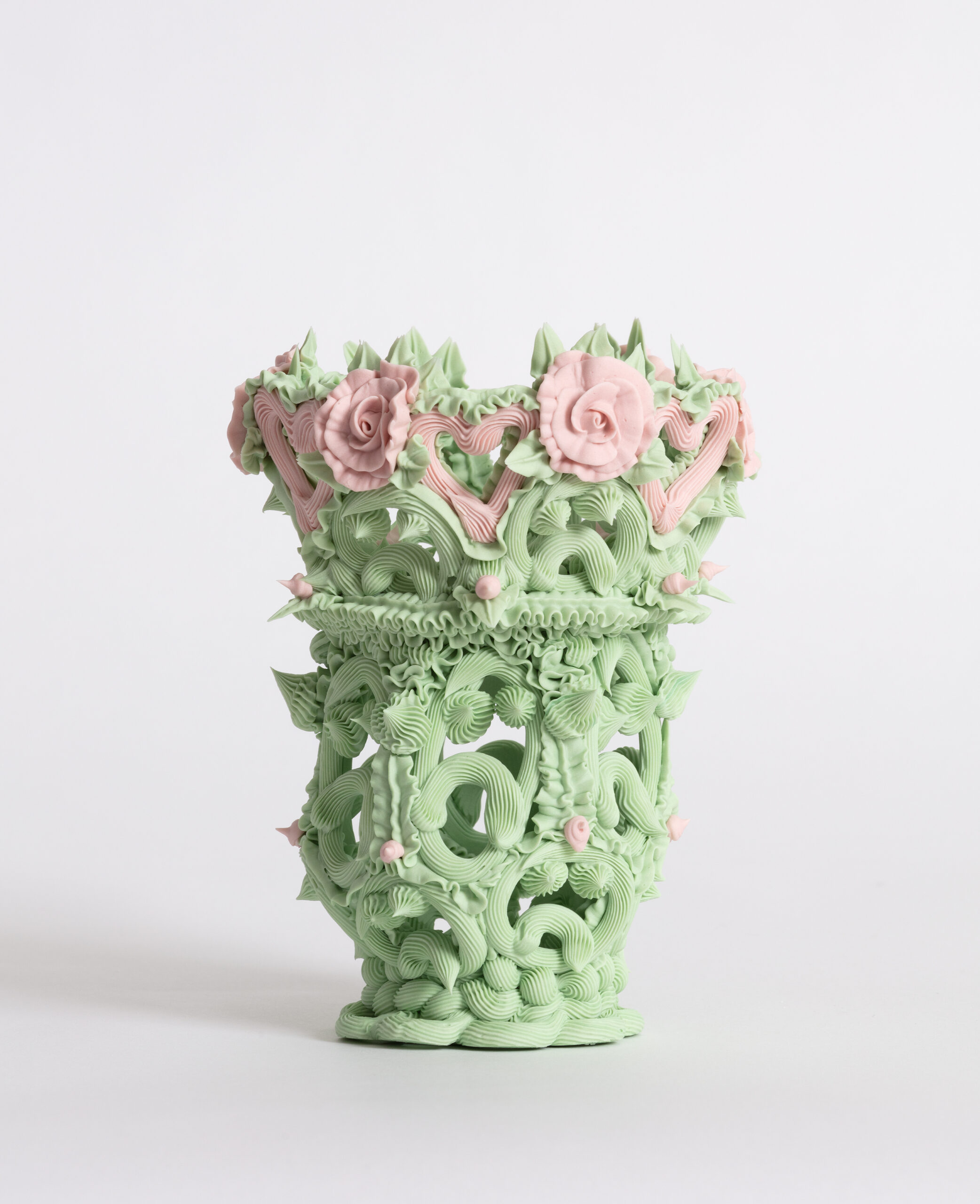
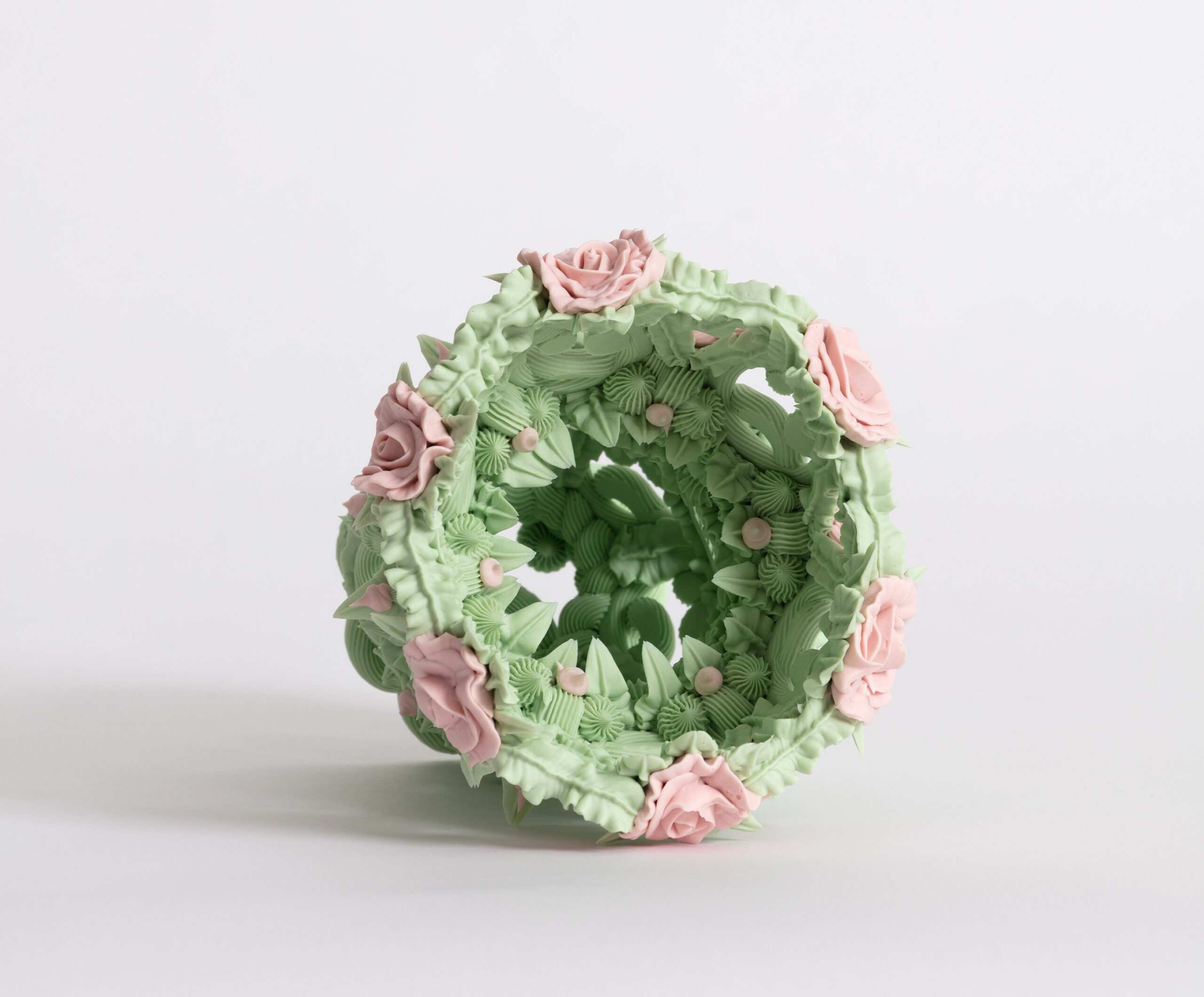
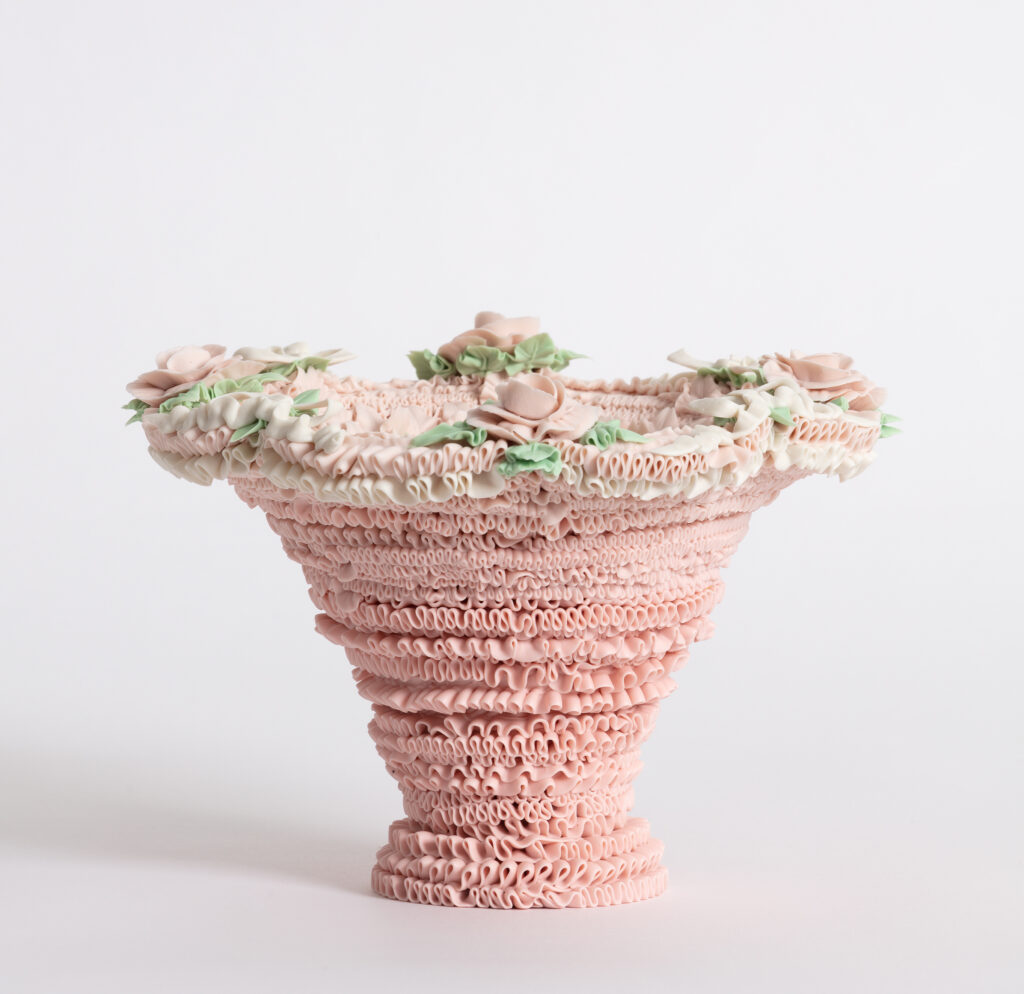
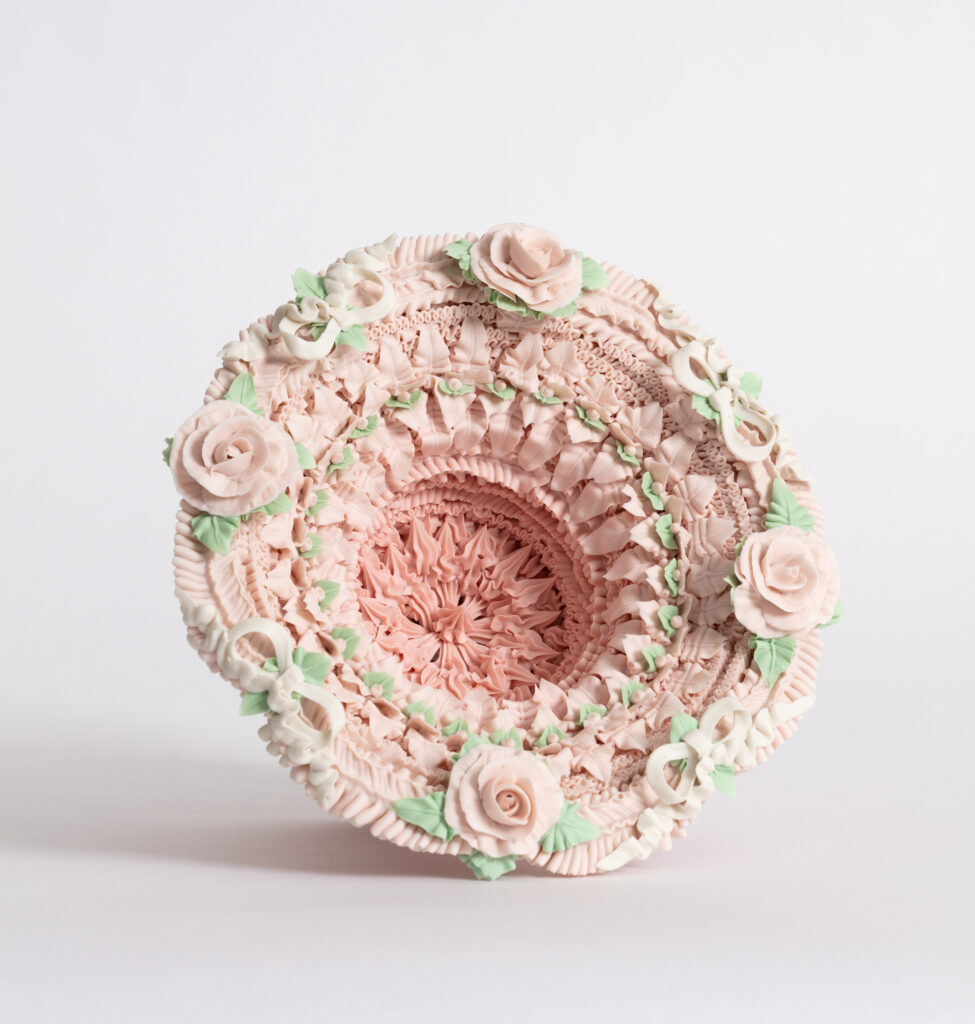
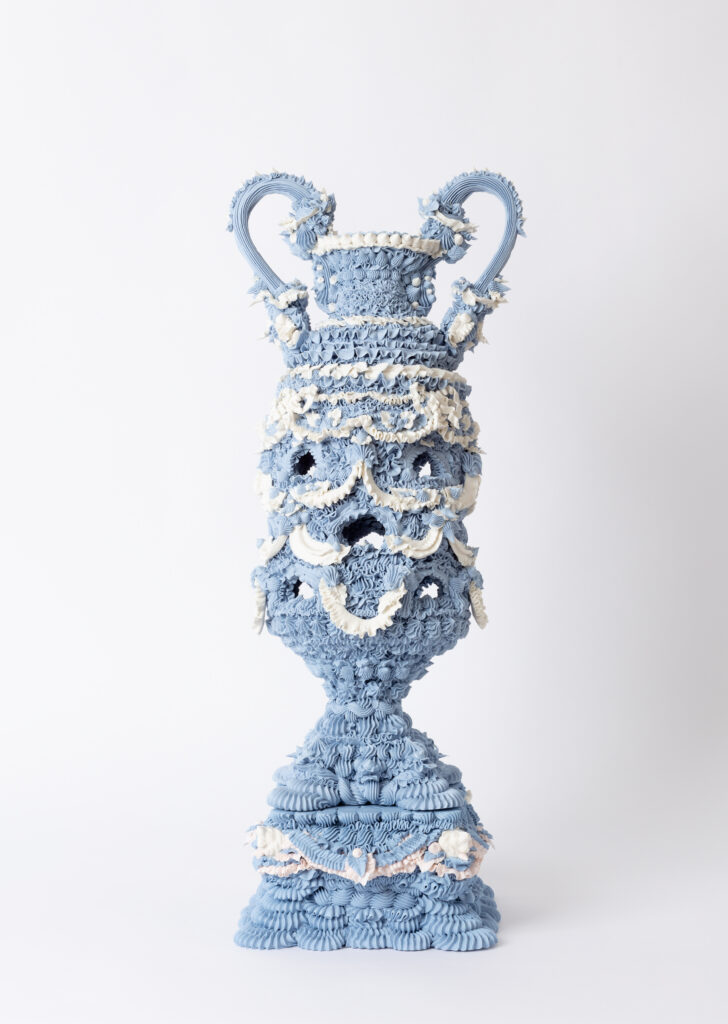
“My practice has been informed by the new and most recent technologies in ceramic construction – digital printing. Without watching these machines at work I may have never attempted making my works out of whipped slurry alone. I often joke and refer to myself as an analogue 3D printer. Handmaking is central to my work – it has to be hand piped to connect me to the matrilineal line of female makers in my heritage and the time spent developing the skill needed to perfect craft practices.
I am trying to make impossible forms out of a very difficult medium using a craft that is excluded. My over the top, saccharine, and frilly forms connect with the denigration of ornament and its relationship to the feminine. I want my work to be a celebration of the things that I am attracted to in art – the things that have often been excluded and dismissed as unnecessary. To make sculptures that are 100% ornament. They take time and patience to make, a layer or two a day. Extremely fragile but once complete they are strong and everlasting.”
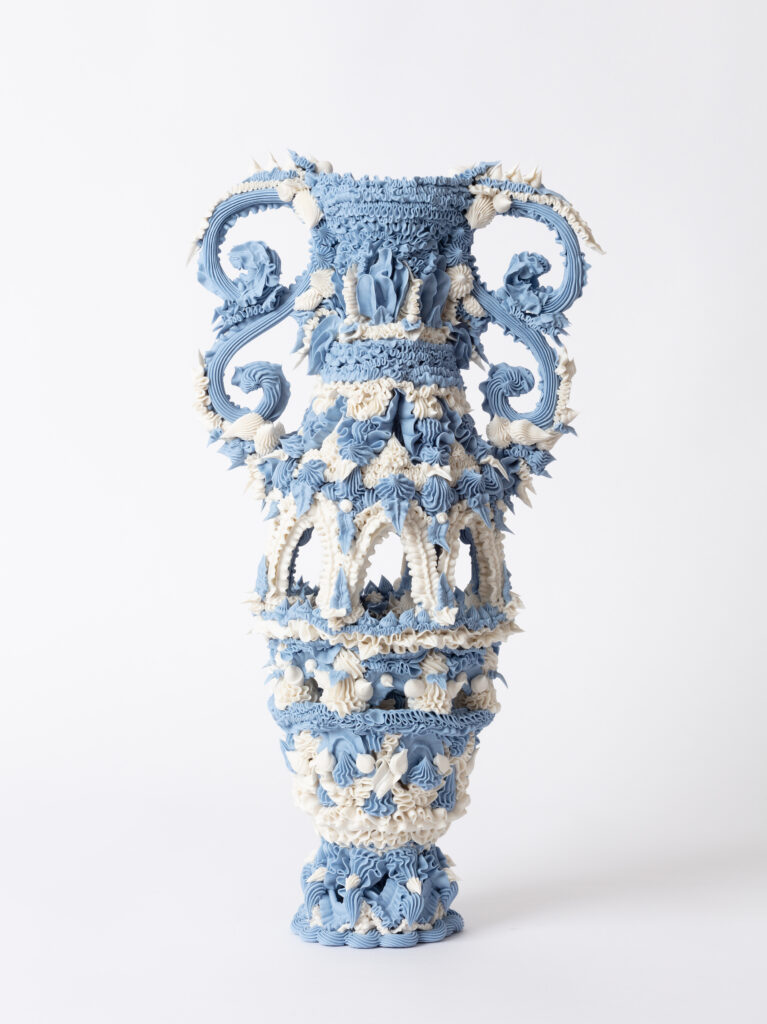

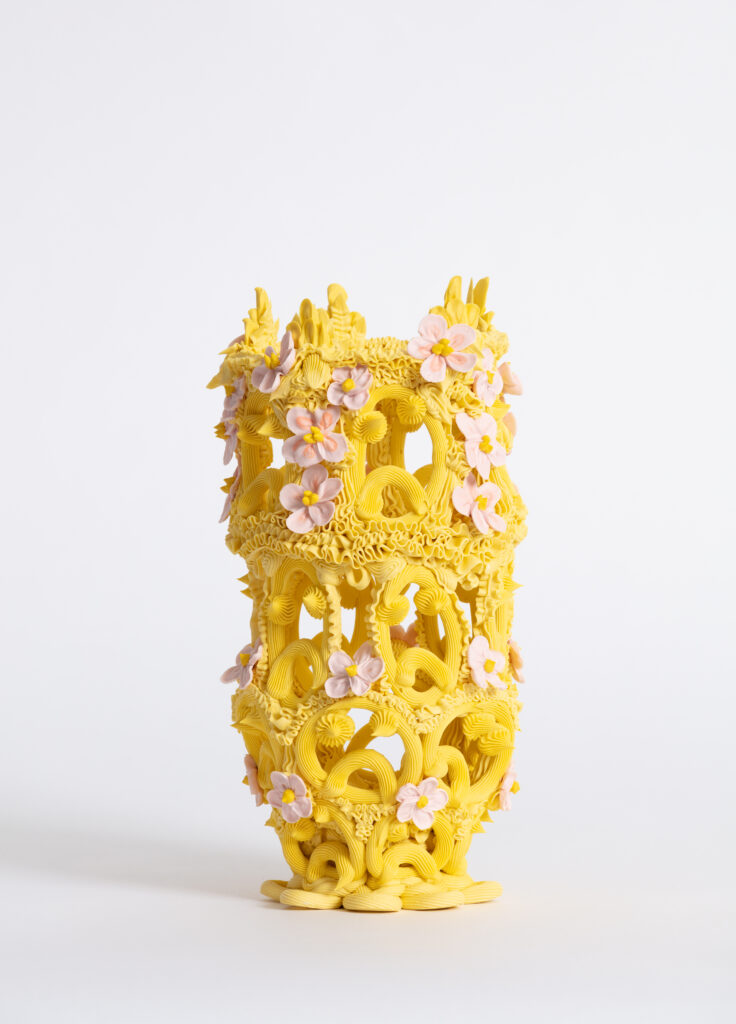
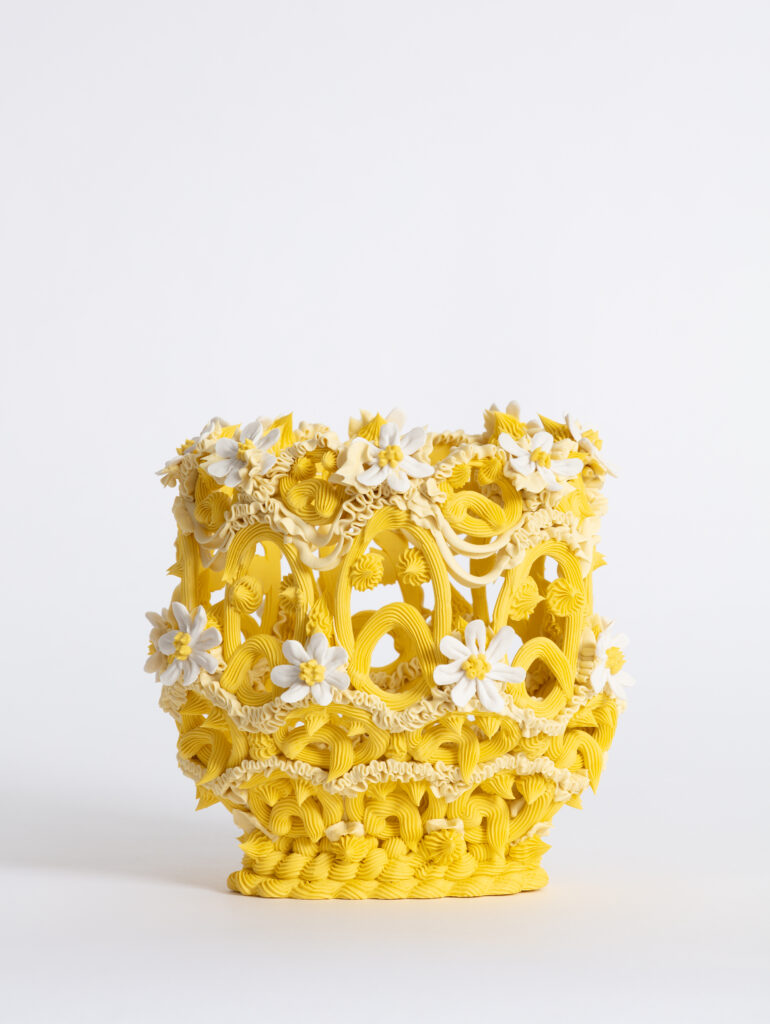
All images by Simon Hewson.
All prices are in Australian dollars and inclusive of GST.
Shipping costs not included – please contact the gallery for assistance with shipping. Prices are correct at the time of publication but may be subject to change without notice. For sales enquiries email: info@artereal.com.au
Indecorum: In Confidence Vase & Pedestal Set
Piped porcelain and stain
54 x 17 x 18 cm (each)
Indecorum: Decorated Decorative Vase With Balconettes
Piped porcelain and stain
38 x 20 x 14 cm
Frown Face: Urn With Finial
Piped mid fire clay, glaze and gold lustre
46 x 18 x 18 cm
Frown Face: Loopy Frown Face Urn
Piped mid fire clay, glaze and gold lustre
36 x 24 x 19 cm
Cry Baby: Frilly Face Urn
Piped mid fire clay, glaze and gold lustre
36 x 23 x 17 cm
Cry Baby: Catch My Tears Chalice
Piped mid fire clay, glaze and gold lustre
22 x 20 x 18 cm
Frown Face: Spiky Frown Face Urn With Finial
Piped mid fire clay, glaze and gold lustre
43 x 18 x 16 cm
Frown Face: Gold Polka Frown Trophy
Piped mid fire clay, glaze and gold lustre
29 x 24 x 17 cm
Frown Face: Gold Frowning Trophy
Piped mid fire clay, glaze and gold lustre
22 x 22 x 17 cm
De•Corum: Sunny Sad Face Jardinière With Daisies
Piped porcelain and stain
17 x 17 x 14 cm
De•Corum: Sunny Sad Face Floral Vase With Flowers
Piped porcelain and stain
23 x 11 x 11 cm
De•Corum: Sunny Sad Face Vase
Piped porcelain and stain
16 x 13 x 13 cm
De•Corum: Proliferation Leaf Comport With Roses & Bows
Piped porcelain and stain
16 x 17 x 16 cm
De•Corum: Minty Sad Face Vase With Roses and Hearts
Piped porcelain and stain
16 x 13 x 13 cm
De•Corum: Pink Flourish Comport With Roses & Bows
Piped porcelain and stain
14 x 19 x 19 cm
Peaches 'n Cream: Urn
Piped porcelain and stain
24 x 25 x 18 cm
Peaches 'n Cream: Puffy Sleeve Urn
Piped porcelain and stain
39 x 37 x 23 cm
De•Corum: Blue Sad Face Vase With Daisies
Piped porcelain and stain
14 x 13 x 13 cm
De•Corum: Blue Spill Vase With Flowers
Piped porcelain and stain
22 x 20 x 15 cm
De•Corum: Blue Sad Face Comport With Pink Flowers & Hearts
Piped porcelain and stain
16 x 16 x 16 cm

